




















































Welcome to the Spring/Summer 2025 edition of This Augusta Community Guide! As we step into the warmth of spring and summer, there’s no better time to embrace the natural beauty, outdoor adventures, and growing opportunities that make our region unique. In this issue, we celebrate the vibrant spirit of our community and invite you to explore everything our area has to offer.
The Shenandoah Valley is a haven for outdoor enthusiasts. Whether you’re hiking scenic trails, kayaking along waterways or on a lake, or enjoying family picnics along the Blue Ridge Parkway, there’s an adventure waiting for everyone. Don’t forget to explore our local farmer’s markets and outdoor festivals, where you can savor fresh produce, discover handmade treasures, and connect with the heart of our community.
This year also marks a time of exciting growth for our local businesses. From new startups to long-standing establishments, our business community continues to thrive, offering unique products, exceptional services, and innovative solutions. Be sure to visit and support these businesses—they are the backbone of our local economy and a vital part of what makes our community special.
For newcomers and long-time residents alike, this guide is your resource to discover the best of our area. Whether you’re planning a day outdoors, looking for services, or seeking ways to get involved, you’ll find everything you need within these pages.
We’re proud of the partnerships and collaborations that fuel our growth and ensure our community remains a wonderful place to live, work, and play. Thank you for being part of it all.
Here’s to an unforgettable spring and summer filled with connection, adventure, and success from your Chamber team.
Courtney, Kim, and Shasta

Chamber staff, left to right, Kim Wilbur, Director of Marketing and Communications; Courtney Thompson, President and CEO; and Shasta Weeks, Director of Membership.




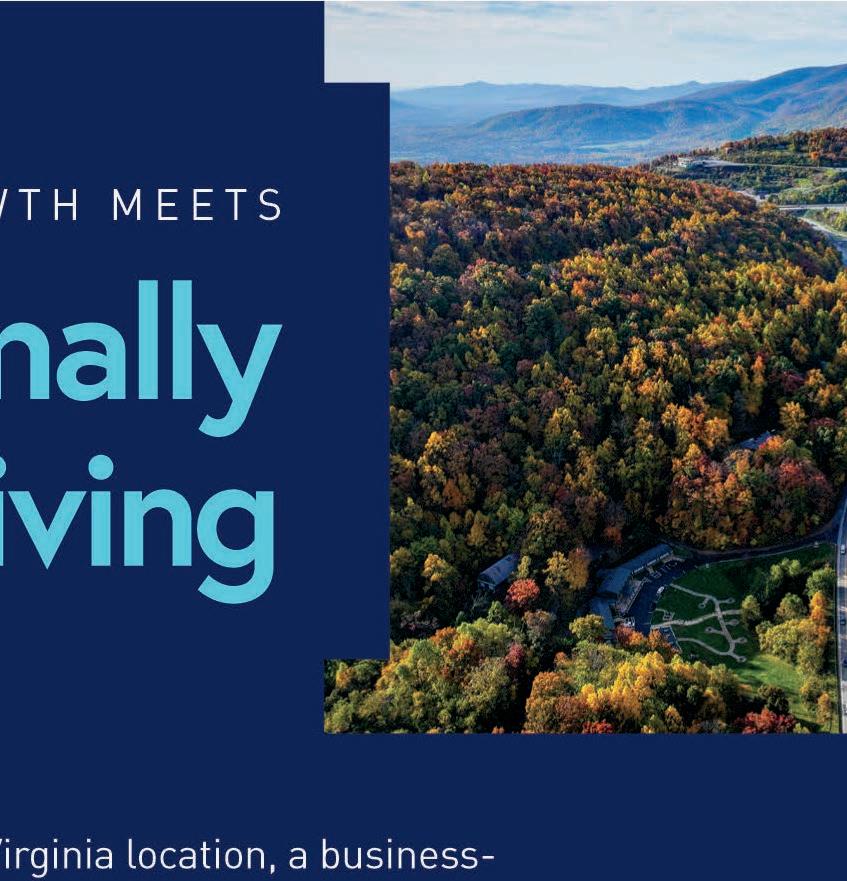



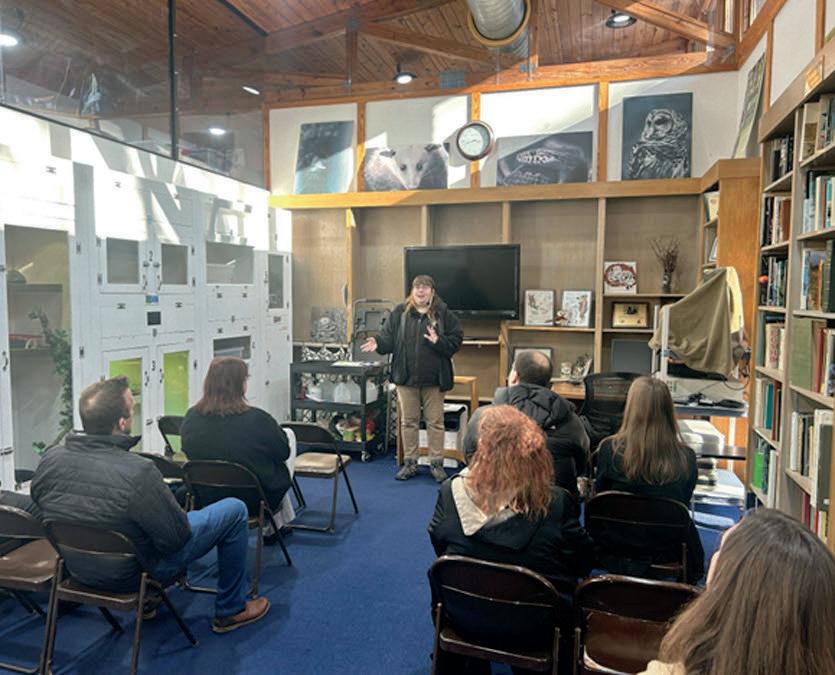





Are you looking to advance your career, grow your professional network, and become a leader in our community? The SAW Young Professionals (SAWYP) program is your opportunity to do all this and more. Designed for ambitious professionals in the early stages of their careers, our YP program provides the perfect mix of professional development, leadership training, and networking opportunities to help you thrive.
As part of the SAWYP program, you’ll gain access to exclusive workshops and seminars led by industry experts. From honing your leadership skills to mastering business strategies, you’ll learn the tools and techniques to excel in your career. We’ll also connect you with seasoned mentors who are eager to share their insights and guide you on your professional journey.
One of the most exciting aspects of our program is the opportunity to meet key community leaders. Through panel discussions, Q&A sessions, and informal meet-and-greets, you’ll build relationships with the people shaping our region’s future. These connections not only inspire but also open doors to new opportunities.
SAWYP will also take you behind the scenes to discover how our community works. From field trips to major employers and local landmarks to tours of innovative businesses and civic institutions, you’ll gain a unique perspective on what makes our area thrive. It’s a chance to see how you can make an impact and contribute to our community’s success.
Networking is at the heart of what we do with a dynamic group of like-minded professionals who are as driven and passionate as you are. Whether you’re looking to find new customers, clients, or collaborative partners, the connections you make here will be invaluable for your professional and personal growth.
It’s more than just a networking opportunity—it’s a way to make a difference. By engaging with other professionals and community leaders, you’ll be positioned to lead initiatives that benefit both your career and the community.
SAWYP membership is free to Chamber members! Learn more at www.augustava.com. <

n the 1920s, a group of businessmen in downtown Staunton came together to form the Staunton-Augusta County Chamber of Commerce. In the 1950s, with Waynesboro becoming a nationally known hub for manufacturing, several plant managers decided to create the Waynesboro-East Augusta Chamber of Commerce. In 1999, a group of forwardthinking business leaders representing Augusta County, Staunton and Waynesboro presented the idea of joining forces and establishing one Chamber to serve the whole area. Thus, the Greater Augusta Regional Chamber of Commerce was born and opened its doors in centrally located Fishersville.
The Greater Augusta Regional Chamber of Commerce exists to help promote a healthy and thriving business community. By helping local businesses and community leaders network and make great connections, providing important resources, and working with state and local governments to advocate for business-friendly practices, we strive to constantly improve the quality of life in our community.
There’s never been a better time to be part of the Chamber! Whether your business is seeking customers, or you need access to resources or leadership training, or being a good corporate partner is part of your DNA, the Greater Augusta Regional Chamber of Commerce is the place to be. “Support local” isn’t just a slogan for us- it’s a way of life and a way of doing business. Count on the Chamber to help you make those connections that really matter. <
Kristina Arbogast
Chair Hotel 24 South
Kevin Ratliff
Immediate Past Chair
Blue Ridge Community College
Chris Auville
Harmony Harvest Farm
Allison Bagley
Augusta Cooperative
Kevin Gabel
Lantz Construction
Piper Groves
Shenandoah Valley Art Center
Wayne Huffman
McKee Foods
Paula Moore-McClure Chair-Elect
Individual Member
Bruce Blair
Secretary
Compass Behavioral Health
Quentin Johnson Visiting Angels
Garth Knight LD&B Insurance & Financial Services
Jaqueline Kurtz First Bank & Trust Company
Jay Langston Shenandoah Valley Partnership
Todd Livick Individual Member
Suzie Dull Treasurer
Mary Baldwin University
Ellen Shaver-Shank At-Large
Augusta County Fair
Kaystyle Madden Shenandoah Valley Workforce Development Board
Joe Meador
Augusta Health
Jodi Tibbs Valley Trust Insurance
Michelle White DuPont Community Credit Union
Nate Wilson NextHome Realty Select



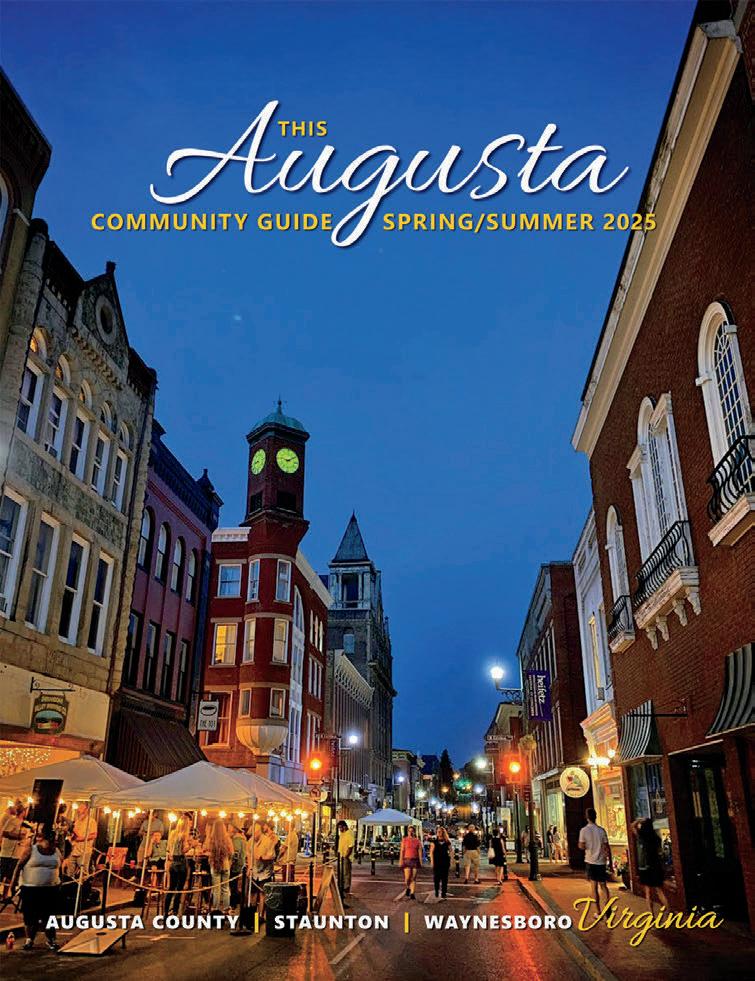






Source: US Census Bureau


Source:








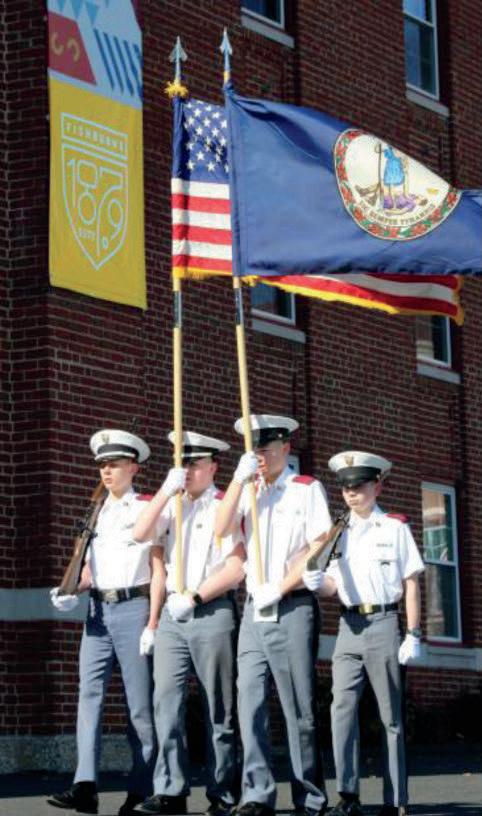





Augusta County 18 Government Center Ln. Verona, VA 24482 (540) 245-5600
co.augusta.va.us
City of Staunton 116 West Beverley St. Staunton, VA 24401 (540) 332-3800
ci.staunton.va.us
City of Waynesboro
503 West Main St. Waynesboro, VA 22980 (540) 942-6600 waynesboro.va.us
Public water and sewer is available in the Cities of Staunton and Waynesboro and areas of Augusta County.
Augusta County Service Authority (Augusta Co. with the exception of Craigsville.) (540) 245-5681
Town of Craigsville (540) 997-5935
City of Staunton (540) 332-3860
ci.staunton.va.us/departments/public-works/utilities
City of Waynesboro (540) 942-6643
waynesboro.va.us/300/utility-billing
City of Staunton (540) 332-3892
ci.staunton.va.us/departments/public-works/trashrecycling-collection
City of Waynesboro (540) 942-6743
waynesboro.va.us/309/Refuse
Augusta County Disposal (540) 949-0160
augustacountydisposal.com
Republic Waste Services (434) 295-4177 republicservices.com
Waste Management of Virginia (540) 434-8720 wm.com/us
Waste Movers (540) 972-3456 wastemoversva.com
Happy Little Dumpsters, LLC (540) 324-3593
happylittledumpster.com/service-area/stauntonwaynesboro-va/
Republic Waste Services (434) 295-4177 republicservices.com
Waste Management of Virginia (540) 434-8720 wm.com/us
Waste Movers (540) 972-3456 wastemoversva.com
Augusta County
www.co.augusta.va.us/residents/water-wastewatertrash-recycling/solid-waste-recycling-locations
City of Staunton ci.staunton.va.us/departments/public-works/trashrecycling-collection/recycling
City of Waynesboro https://www.waynesboro.va.us/292/Recycling

Dominion Energy (866) 366-4357 Dom.com
Shenandoah Valley Electric Cooperative (800) 234-7832 svec.coop
Columbia Gas of Virginia (800) 543-8911 columbiagasva.com
Amerigas (540) 885-6168 amerigas.com
Quarles Petroleum (877) 444-3835 quarlesinc.com
Southern States Cooperative-Augusta Petroleum (540) 886-2501 southernstates.com
LANDLINE )
Lumos Networks (844) 675-1338 lumosfiber.com
Verizon (800) 837-4966 verizon.com
AT&T (800) 331-0500 att.com
Boost Mobile (540) 305-3916 boostmobile.com




Cricket Wireless (540) 707-0341 cricketwireless.com
T-Mobile (540) 609-2879 t-mobile.com
Verizon (800) 837-4966 verizon.com
Xfinity Xfinity.com
Lumos Networks (844) 675-1338 lumosfiber.com
GloFiber (877) 492-6845 glofiber.mco
Lingo Networks (540) 712-0300 lingo-networks.com
Augusta County Main Library 1759 Jefferson Highway Fishersville, VA 22939 (540) 885-3961 or (540) 949-6354 augustacountylibrary.org
Augusta Co. Library - Churchville 3714 Churchville Ave. Churchville, VA 24421 (540) 245-5287
Augusta Co. Library – Craigsville 18 Hidy St. Craigsville, VA 24430 (540) 997-0280
Augusta Co. Library – Deerfield
59 Marble Valley Rd. Deerfield, VA 24432 (540) 939-4123
Augusta Co. Library – Middlebrook 3698 Middlebrook Rd. Middlebrook, VA 24459 (540) 885-1008
Augusta Co. Library – Stuarts Draft
Broadmoor Plaza, Suite #107 Stuarts Draft, VA 24477 (540) 569-2683
City of Staunton
1 Churchville Ave. Staunton, VA 24401 (540) 332-3902 stauntonlibrary.org
City of Waynesboro
600 S. Wayne Ave. Waynesboro, VA 22980 (540) 942-6746 waynesboro.va.us/354/library
Local Bus
BRITE Transit (540) 943-9302 britebus.org
Commercial Air Service
Shenandoah Valley Regional Airport (SHD) (540) 234-8302 flySHD.com
Flight Schools
Blue Ridge Aviation (540) 246-9407 flyblueridgeaviation.com
General Aviation Services
Eagles Nest Airport (540) 943-4447 eaglesnest.aero

Amtrak 800) 331-0008 amtrak.com
VEHICLE REGISTRATION
Virginia Department of Motor Vehicles (866) 368-5463 dmv.virginia.gov
17 1st St., Staunton, Va 24401 998 Hopeman Pkwy., Waynesboro, VA 22980
Augusta County Voter Registration
18 Government Center Ln. Verona, VA 24482 (540) 245-5656
co.augusta.va.us/government/departments-andoffices/voter-registration
City of Staunton
City Hall
116 W. Beverley St. Staunton, VA 24401 (540) 332-3800
ci.staunton.va.us/departments/registrar
City of Waynesboro
Office of Voter Registrar 605 Market Street
Lower Level of the Waynesboro Library Waynesboro, VA 22980 (540) 942-6620 waynesboro.va.us/126/Voter-Registration





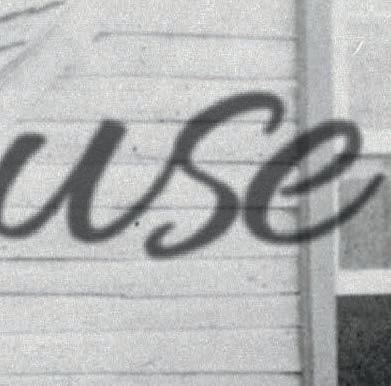



By Heather S. Cole




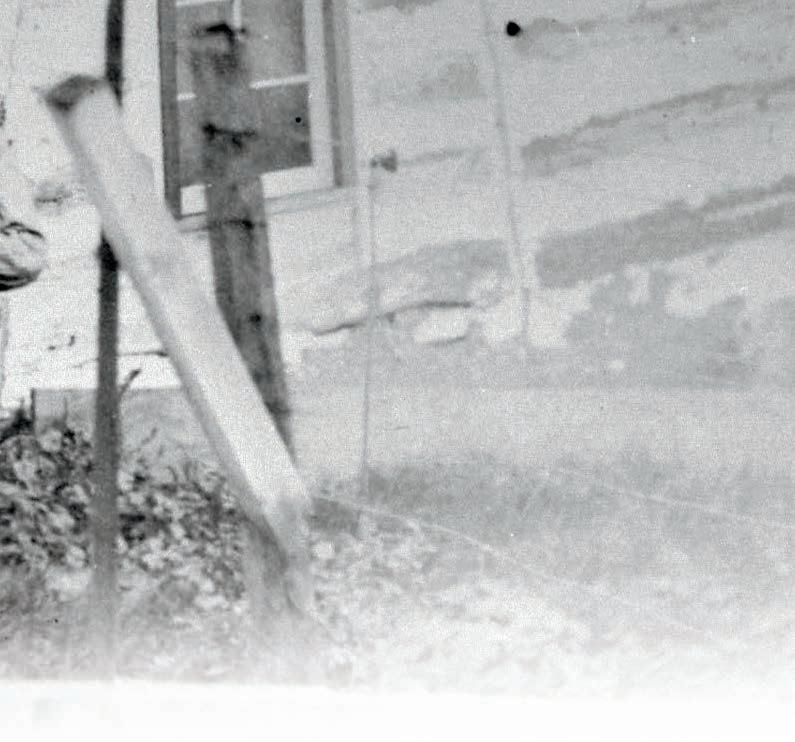
In 1866 — just one year after the end of the Civil War — freedman Edmund Cabell spent $50 to buy a piece of land at what is now 654 East Beverley Street in Staunton. On the land adjacent to the Virginia School for the Deaf and Blind, Cabell built a single-story log house for his wife, Evaline Boyers Cabell, and their children. It was a modest home, surrounded by the grandeur of the nearby Gospel Hill mansions, but it was home. And the house — expanded to include two rooms, a kitchen, bathroom and attic space over the years — would remain home to generations of the Cabell family for more than a century.
Early last year Historic Staunton Foundation (HSF) — a nonprofit organization focused on promoting the preservation and revitalization of architecture and historic resources in Staunton — purchased the Cabell Log House and has embarked on an effort to document and preserve the historic building. According to HSF, the structure is a rare example of a post-Civil War home built by an African American and is the only remaining 19th century exposed-log structure in Staunton.
“We are thrilled to have this opportunity to preserve another piece of Staunton’s history,” said Kelly Grantier, past president of HSF. “We are excited to work with local experts and community members to collect and share the story of the Cabell family and the larger history of the African American community in Staunton.”
Top:
Bottom:


The Cabell Log House had fallen into disrepair over the years and was no longer inhabitable by the time HSF acquired it. The first step HSF took was to secure and stabilize the building: removing trees that had grown too close to the house and redirecting rainwater runoff away from the foundation.
The next step was to begin the documentation of the house and surrounding property. Dr. Dennis Blanton, professor of anthropology at James Madison University in Harrisonburg, Va., worked with a group of undergraduate archaeology students to conduct a survey of the land surrounding the house. Over the past year, they dug several test pits and collected artifacts from the soil, which were then cleaned and catalogued. They then mapped the location of the artifacts they found — glass, nails, ceramics, animal bones and cinders — which allowed them to identify the location of what they believe to have been an outhouse on the property, giving clues as to how the land was used over time.


An expert from the University of Virginia, 3D technologies specialist Will Rourke, documented the interior and exterior of the Cabell Log House via laser scanning. Rourke took 44 scans containing more than 800 million data points, which were then used to create digital models of the house. According to HSF executive director Frank Strassler, the information Rourke collected can be used to better understand how the house was built and guide the preservation process.
“Studying the Cabell house over the past year has revealed hints that warrant further study,” Strassler said. “Our partnerships with the University of Virginia and James Madison University have provided the project needed technological tools” to better document the house.
In addition to the physical documentation of the house and grounds, HSF is also working to record the history of the people who lived in the house over the decades. Among those working on documenting this part of the house history are historian Dr. Lynn Rainville, who has been researching the African American community in the Gospel Hill neighborhood of Staunton (where the Cabell Log House is located), and journalist Randi B. Hagi, who reported two stories on the Cabells for WMRA, a NPRaffiliate radio station based in Harrisonburg, Va. HSF board member Cynthia Easterling has traced the Cabell family descendants in municipal property records across the county.



“Black history is extremely difficult to research,” Easterling said. The Cabells, like many African American families, trace their history back to the time when their ancestors were enslaved. Oftentimes, Easterling said, the only historical records that may exist for African American families from that period are records that were kept by their white enslavers. So it is particularly important to collect and preserve what can be found. “Black history is American history. And we will lose the stories if we don’t document and share them.”
HSF has not yet determined what will become of the Cabell Log House once it is fully documented and stabilized. The organization has assembled an advisory committee comprised of preservation professionals, members of the local community and other stakeholders to make recommendations to HSF. Their work is ongoing.
In the meantime, HSF is sharing the results of their research on the Cabell Log House with the public and welcomes anyone interested in volunteering. More information can be found on their website at www.historicstaunton.org. <
Heather S. Cole is a member of the board of directors of Historic Staunton Foundation.


By Matt Paxton
Waynesboro’s Fishburne Military School and Fishburne Middle School embody both the old and the new in education. Fishburne Military School is the oldest operating military secondary school in the Commonwealth, while Fishburne Middle School is finishing its first year of operation this spring.
Fishburne Military School was founded in 1879 by James A. Fishburne. Fishburne was born in Waynesboro in 1850, and attended Washington College (now Washington and Lee University) in Lexington, graduating in 1870. He was attracted to teaching, and dreamed of opening his own school. After stints teaching in North Carolina and Kentucky, he returned home to Waynesboro. With help from his sister, Fishburne opened
the Waynesboro High School in the old Taylor Building on Main Street. Initially a day school, the first class consisted of thirteen boys and girls. The next year, he expanded into the old Waynesboro Academy Building, hired an additional instructor, and began seeking boarding students.
Also that year, 1880, he began building his home, located on the hill where Fishburne Military School stands now. The house was finished in 1882, and the school moved its present site. In addition to Fishburne and his wife; instructors and boarding students roomed, ate and studied in the two-story house with full basement. Reportedly, the house was the first in Augusta County to have running water and a bath, water being pumped from a spring on Wayne Avenue.

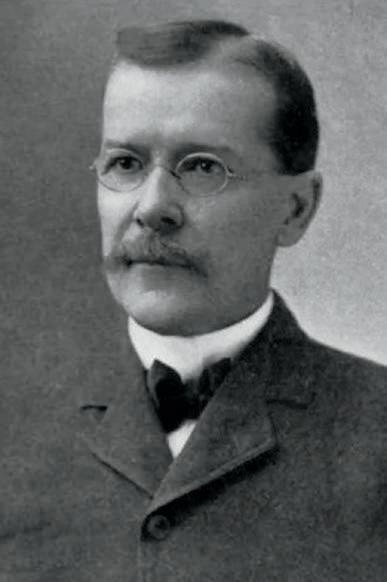
By the mid 1880s, the schools essential character was defined: only boys were admitted, uniforms were required, and a military approach to education aimed to instill discipline while being conducive to learning. A wooden barracks had been build next to Fishburne’s home, which would be enlarged several times before being torn down in 1917 after completion of the current fireproof brick structure. The new barracks building was designed by noted Staunton architect T.J. Collins. Additions to the brick barracks and construction of other building followed over the decades.



Following the death of James Fishburne in 1921, he was succeeded by Morgan H. Hudgins. Hudgins was a Virginia Military Institute graduate who had joined Fishburne Military School in 1901 as Commandant of Cadets and Associate Principal. He was to be an integral part of the school for 51 years.
To help finance the physical improvements made in the early 1900s, Fishburne incorporated the school in 1916 and sought local investors. The school functioned as a private stock corporation for decades, but by the late 1940s, that model was not working. Losses and inability to find new investors forced the stockholders to sell the school in 1951. The City of Waynesboro bought it, with plans to transform it into the Waynesboro city building. But local civic leaders, friends and alumni saw this as the loss of a community asset and to Waynesboro’s heritage. They formed the FishburneHudgins Educational Foundation, and bought the school back from the city after only a few months, enabling Fishburne Military School to continue uninterrupted. The foundation continues to operate the school in perpetuity.
Besides a rigorous academic program, the school’s Junior Reserve Officers Training Corp program has received recognition. Fishburne’s cadet corps was rated an honor military school in 1924, and has never failed to receive this distinction annually since. It is the only Junior ROTC school in the nation with this record.
Notable graduates of Fishburne include former Virginia Governor Gerald Baliles, singer-songwriter Jonathan Edwards, and national security analyst John Noonan.
Today, Fishburne Military School’s mission remains consistent with James Fishburne’s vision : to make Fishburne cadets “wellequipped for the duties and responsibilities of life, and above all else, to maintain a high standard of honor and integrity in the Corps of Cadets.”
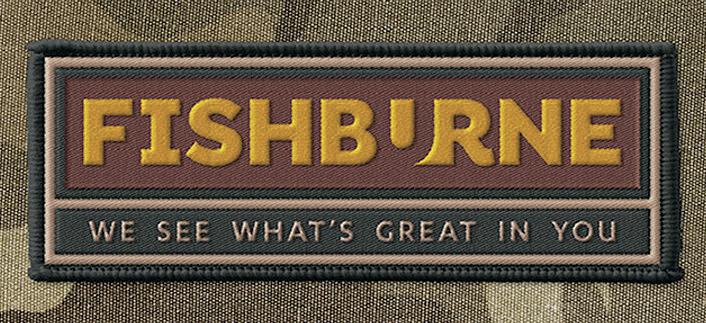
While the Military School dates back almost 150 years, Fishburne Middle School is just completing its first year of operation as a non-military day school. For the first year, the middle school was for boys in the sixth and seventh grades, but for the 2025-26 school year, the middle school will encompass sixth through eighth grade. Also, Fishburne acquired First Presbyterian Church, which is adjacent to the Fishburne Military School campus. Fishburne will begin to utilize the additional space on campus this coming fall.



Fishburne Middle School offers a classical curriculum grounded in core subjects: science, language arts, history and math. Specialized classes in foreign languages, finance, health and physical education and technology are offered. Art classes are through the Wayne Theatre, focusing on drama and theater tech. Students have an input into the formation of school-based clubs in such areas as chess, robotics, woodworking, drafting and aeronautics. Seventh and eighth grade boys may qualify to participate in selected high school sports at Fishburne Military School such as cross country, JV soccer, JV basketball, JV track and lacrosse.
While similar military schools in the area have not survived into the 21st century, Fishburne Military School continues to offer an alternative educational experience for those boys seeking the benefits of a more structured environment. And, the new Fishburne Middle School is offering a similar atmosphere of structure, with small classes and individual attention to help boys gain a foundation for success in high school and beyond. Both appear to be succeeding at keeping James Fishburne’s legacy alive and thriving. <



By Matt Paxton
Augusta County and adjoining counties are blessed with thousands of acres of protected natural areas, ranging from Shenandoah National Park to the George Washington and Jefferson National Forest. Within the national forest, which encompasses over 1.6 million acres in western Virginia and parts of Kentucky and West Virginia, there are 23 Wilderness areas. For the U.S. Forest Service, wilderness refers to a designated area of national forest land established as Wilderness by an Act of Congress, as a part of the National Wilderness Preservation System (NWPS). The Wilderness Act of 1964 legally defines Wilderness as an area “where the earth and its community of life are untrammeled by man; where man himself is a visitor who does not remain.”
Augusta County contains two Wilderness areas — Ramsey’s Draft and Saint Mary’s. Ramsey’s Draft Wilderness is west of Staunton off Rt. 250. Saint Mary’s Wilderness is in the southeastern part of the county. Its over 9,000 acres lay on the western slopes of the Blue Ridge between the Blue Ridge Parkway and the foot of the mountains. The Saint Mary’s River and its watershed define much of the Wilderness area. Elevations in the Wilderness area range from 1,700 feet to 3,640 feet. Saint Mary’s Wilderness contains roughly 17 miles of hiking trails.
The Saint Mary’s Falls trail is the most popular in the Wilderness — indeed, it’s one of the most used trails in the area. The gorges formed by the Saint Mary’s River and Spy Run have created spectacular steep slopes. The clear water, sometimes in slow-moving pools and at times cascading over the sandstone rocks, are almost always in sight on this hike.
Beginning in 1948, the river was stocked with brook and rainbow trout, and continued until 1974, when high water washed out the access road. The river continues to support native brook trout and naturalized rainbow trout. Anglers are allowed to take up to six trout with a minimum 9-inch length per day — but catch and release is encouraged. See the Virginia Department of Wildlife Resources (DWR) page on fish in the Saint Mary’s at dwr.virginia.gov/waterbody/ st-marys-river/#fishing.
The Department began monitoring fish and invertebrate populations in 1976, and continues to do so. Since 1987, DNR has been monitoring the chemical characteristics of the water through funding an ongoing study by the University of Virginia and citizen volunteers. The data shows that the Saint Mary’s River is an acidified stream, resulting from acid precipitation and from the rocks it flows over. This explains the decline in populations of acid-sensitive fish and invertibrates. To ameliorate this acidification, periodically the river and five of its tributaries are ‘dosed’ with limestone sand. This is done by helicopters which dump the sand directly into the streams. This raises the Ph in the water and has provided encouraging results.
Bottom: The reward for the 2.2-mile hike up the Saint Mary’s River is this view of Saint Mary’s Falls.





The 4.4 mile round trip hike from the parking lot at the end of Saint Mary’s Road follows the Saint Mary’s River upstream to the falls. The last mile or so is considered moderate, but when hiked in November, 2024, there were areas that were washed out and required scrambling down rocks and hiking along the riverbed. The trail is not marked with blazes but isn’t hard to follow.
As you hike, you may see evidence of manganese mining that occurred in the Saint Mary’s region in the early 1900s. There was even a railroad that ran up the Saint Mary’s to the mouth of Chimney Branch, and parts of the right-of-way can still be discerned.
The hike up to the falls requires five crossings of the stream. A regular hiker of the trail told me that many of the large stepping stones placed at the crossings have been washed downstream, but I found the crossings to be manageable. I was glad I had waterproof boots on, though, because I did dunk a foot several times. A hiking stick is helpful with balance on the crossings and on narrow and uneven sections of the trail. The reward of the view of the falls at the turnaround point is well worth the effort.


An alternate hike to the falls is the Mine Bank Trail. Pick up the trailhead off the Blue Ridge Parkway at milepost 23 near the Fork Mountain Overlook. There is a small parking area on the west side of the Parkway. This is a longer hike than the Saint Mary’s Trail at five miles roundtrip. The Mine Bank Trail intersects the Saint Mary’s Trail at the 2-mile point. Take a right on the Saint Mary’s to go up to the falls.
The Virginia Wilderness Committee has more on these hikes and others in the Wilderess area at www.vawilderness.org/ st-marys-wilderness.html.
From left clockwise: The trail follows the Saint Mary’s River. Map of the Saint Mary’s Wilderness Area. The Saint Mary’s River flows through a gorge that narrows as you hike up to the falls. Another view of the fall.
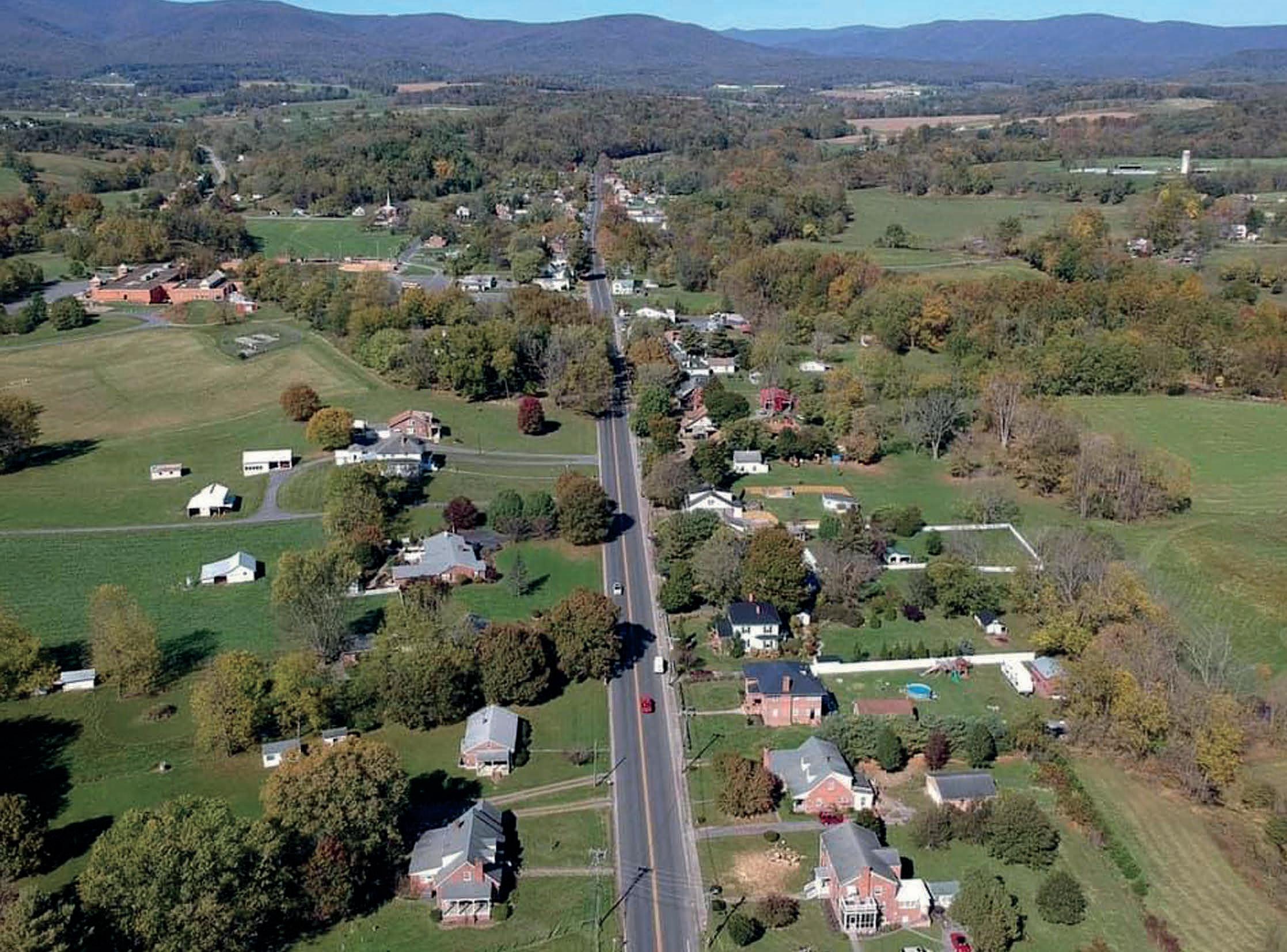



By Courtney Thompson
Churchville, Virginia is a small unincorporated community in western Augusta County with a rich history, a close-knit population, and a charm that reflects its rural roots.
Churchville’s history dates back to the 18th century when settlers moved into the Shenandoah Valley, drawn by fertile farmland and the promise of a new beginning. Originally known as “Jennings Branch,” the community adopted its current name in the early 19th century due to the prominent Presbyterian Church located at the heart of the village and served as a central meeting point for the people of the area.
During the Civil War, Augusta County, including Churchville, played a strategic role due to its location and agricultural resources. The community maintained its rural character even as the surrounding areas modernized, making it a living testament to the history of rural Virginia.


Among its notable citizens is W. Taylor Reveley, III, 27th President of the College of William and Mary, who was born in Churchville in 1943. Also of note is James E. Hanger, born near Churchville in 1843. Hanger lost a leg at the Battle of Phillipi in 1861. Dissatisfied with the prosthetic leg he received, he invented a new type of prosthesis that fit and functioned better, which he patented in 1871. Other inventions aiding the disabled followed, and his company, J.E. Hanger, Inc., now known as Hanger, Inc., is a $1.1 billion company today, with offices worldwide. The company’s website says its mission is to positively impact the lives of others who have shared a similar experience to James Hanger’s.


Churchville is currently home to a modest population of families, retirees, and individuals who appreciate its peaceful setting. The Churchville branch of the Augusta County Library is available to residents five days a week and offers several book clubs, arts and crafts events, and programming for all ages from toddler storytime to the monthly VPAS Cafe for seniors. Churchville Elementary serves pre-kindergarten through fifth grade and has around 450 students. Parents and students report they enjoy the family atmosphere at CHES and everyone in the community proudly sports black and gold to cheer for the Buffalo Gap High School Bison!
Despite its small size, Churchville is home to several locally owned businesses that contribute to its unique character. One standout is Bear Funeral Home, which has been family owned and operated for over 200 years. Currently operated by siblings Will, Jill, and Judi, Bear Funeral Home is well known for their compassionate and outstanding service and their support of the Churchville community.
Augusta Health operates a family practice on Churchville Avenue. This is very convenient for Churchville residents to receive primary care close to home.





continued on page 18


Just a few miles outside of Churchville proper on Hanky Mountain Highway is the Buckhorn Inn and Tavern. Built in 1811 and originally operated as a stagecoach stop, The Buckhorn Inn has been serving travelers and locals for over 200 years. Its history is as rich and colorful as the property it sits on. The Tavern and Inn served as an infirmary during the Civil War, and a place to gamble, dance, eat, drink, and a home away from home for generations.
The Buckhorn Inn and Tavern was renovated in 2021 and offers locally sourced farm to table meals, beer, wine, and carefully crafted seasonal cocktails Friday through Sunday. The Sunday brunch menu is a favorite with many and you’ll find the parking lot and large dining rooms filled with happy diners. Lodging is available full time with several well-appointed rooms and suites available. Owners Brenda and Jack say, “The Churchville area is such a beautiful part of Augusta County and the people have been so supportive and welcoming. We are thrilled to be serving the valley in this community!”


Located along the George Washington National Forest, Churchville’s rural setting is ideal for outdoor enthusiasts. The surrounding area offers stunning views of the mountains and rolling farmland and abundant opportunities for hiking, fishing, and hunting.
SpecialChurchville surely embodies the charm of small-town America, with its rich history, close-knit community, and locally owned businesses. For visitors and residents alike, it’s a place where time slows down, and the simple joys of rural living shine. <
thanks to Judi Bear Delp for her assistance with this article and for her beautiful contribution, which we’ve shared in its entirety.
Churchville is a wonderful place to call home. Many have enjoyed living here their entire lives, including my siblings and myself. Countless others who love their Churchville roots live across the nation and around the world, and still call Churchville “home.”
It is also home to quite a few whose beginnings were elsewhere but, in following a sweetheart or a job to the valley, or when seeking a place to retire, they discovered the charm of Churchville and decided to stay.
Churchville’s charm lies partially in its particular proximity to towns and cities, which gives us access to nearly every comfort and convenience, yet allows us to maintain a pleasant sense of country. A more significant element of Churchville’s charm, though, is its sense of community. In a broader culture that lends itself to isolation and self-focus, many Churchville residents still understand the value of “together.” It is evident in our church communities; in our local shops where customers quickly become treasured friends; in organizations like the food pantry, the H.E.L.P. Center, and service clubs where people devotedly work together for the benefit of their neighbors; and certainly with our first responders.
Community in Churchville is clearly evident in many other realms — summer ball games, scheduled activities at the public library and the community park, and community members simply doing their jobs well, whether the postmaster, the local mechanic, or the hairdresser.
My brother Will, sister Jill, and I grew up watching our parents enhance that sense of community through their work at Bear Funeral Home — just as our Dad had learned from the generations of his family that preceded him in the same work. The honor of serving the community in this way is now ours. We are grateful that the Lord allows us, along with our dedicated support staff, to walk with grieving families through their unique and often devastating experiences of loss, and we trust Him for the grace and wisdom to serve each family well.
Charming Churchville. There’s no place like home.



By Ruth Chodrow and Karen Lynne Johnston
Newcomers to the Staunton-Augusta community in the past two decades may have no idea that Staunton had a lively Jewish community that played a key role in the commercial life of the town and region. Someone shopping at boutiques on Beverley Street today or enjoying a gourmet meal at one of today’s fine restaurants might not understand that this street was once the commercial heart of the entire city and county. In the era before national chain stores in malls or big box stores on the edge of town, mercantile establishments on Beverley Street met nearly all the material needs of the locals. In Staunton, many of those stores were owned and operated by members of the local Jewish community. In this respect, Staunton was typical of hundreds of Southern towns and small cities at that time, and is typical still in experiencing the near disappearance of that Jewish mercantile community once so vital to the commercial life of the town.


In the late 1800s and early 1900s, downtown Staunton was a bustling place filled with stores, warehouses, and shops of all kinds. A stroll downtown would show store after store owned and operated by merchants with Jewish names — Loeb, Switzer, Cohen, Weinberg, Strauss. Who were these people, and how did they come to Staunton?
Most Jews who came to America at that time period were escaping from Central and Eastern Europe. Persecutions, discrimination, and lack of economic opportunity all played a role. In many European countries, Jews were not allowed to own land, pursue higher education, or work at certain trades; they hoped to escape poverty by emigration. Political unrest, such as the failed revolutions of 1848 in many European countries, may have spurred others to leave.
Jews coming to America tended to congregate at centers of trade, mostly large cities. However, some merchants who may have started in Baltimore, Richmond, or Charlottesville found their way down to Staunton at the turn of the century — at that time a busy minimetropolis with a train line right into town.
Jews started coming to Staunton in the mid-1800s and in 1876 started meeting in each others’ homes. By 1886 there were enough Jews to form a congregation, Temple House of Israel, and to purchase a building on Kalorama Street for use as a synagogue. The minutes of the first congregational meeting listed 24 men, almost all of whom were merchants. These merchants were primarily from states in today’s Germany, including the part that was then called Prussia. In the minutes of the congregational meeting of February 1, 1885, the members all pledged to close their businesses on Fridays at 7:00 p.m. in order to attend worship services at 7:30 p.m.
Please note that the street addresses are from the records of the times. Over the years, street numbers downtown have changed dramatically, sometimes more than once.


Inset: From an advertisement which read: KLOTZ BROTHERS, Furs, Hides, Wools, Iron, Metals, Waste Materials, Staunton, Virginia, is one of Augusta county's oldest firms, having been established in 1899. From the Collection of Richard and Thomas Hamrick


Young Jacob and Amos Klotz, with their parents, came from Russia in 1888, and the family settled in Hanover, MD. In 1900, 19-year old Amos was a junk dealer there. Jacob and Amos were traveling peddlers working out of their horse-drawn wagon. They came down from Maryland, passing through Staunton on their way to Ohio. In Staunton, their horse died, and they couldn’t afford a replacement.



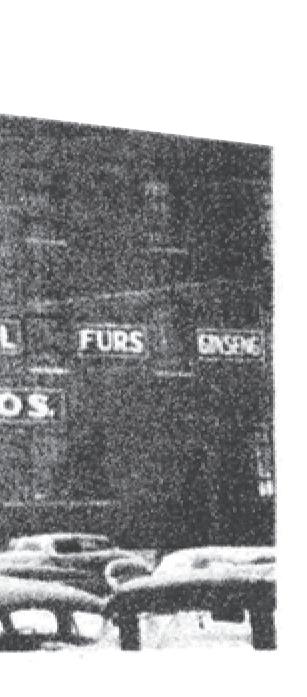
By 1904, Amos had rented an area of land near Lewis Creek and Lewis Street, which was used as a junkyard. They bought and sold scrap metal, wool, furs, rubber, rags, ginseng, hides — just about anything. Amos bought the property in 1917. Eventually two more brothers, Morris and Elie (Alex), joined the business. They purchased a giant electromagnet to pick up the loads of scrap iron.
The Klotz brothers prospered, and in 1929 built a large building at South Lewis Street, currently the location of Sunspots Studios. It is assumed that the date 1899, prominently featured on the building, was the date that Amos and Jacob decided to go into business together. The Jewish mezuzah which they affixed on the door when they opened is currently in the historical exhibit case at Temple House of Israel.
The brothers were very different. Amos didn’t know how to read or write. However, he could sign his name. It was with his characteristic large handwriting that he signed his will, which left generous bequests to multiple Jewish charities and institutions. Jacob was described as “crude and swearing”, and always wore shirts and khaki trousers. Morris, the youngster of the family, always wore a coat and tie, was a member of Rotary, and was a “gentleman by anyone’s standards.” However, he always made sure to carry a magnet in his coat pocket, to check on the scrap metal that was brought in. Morris also served as a trustee of the temple.

Simon Barth opened “Augusta Clothing Hall” in the early 1870s. After he died his brother, Joseph L. Barth, took over the business in 1881. The name was changed to “Barth Clothing Store.”
Joseph Barth came to Staunton from Philadelphia, having come there from Wuerttemberg. He was one of the original members of the congregation. Joseph Barth went into partnership with Lamartine G. Strauss from Yorkville, South Carolina. In 1884 he established Jos. L. Barth and Co., Clothiers, specializing in men’s and boy’s clothes. The store was noted for the excellent quality of its clothing. By 1887 he held a position as a trustee of Temple House of Israel, and was involved in purchasing the Hoover House on Kalorama Street which would become the first temple for the congregation. Joseph Barth was also the first treasurer of Temple House of Israel. His partner L.G. Strauss married Mr. Barth’s sister Regina in 1890. Their daughter Fannie B. Strauss became a noted teacher at Mary Baldwin College.
Abraham Weinberg (1868-1943) came to Staunton in 1895. He was listed in the Staunton 1900 census as being born in Germany in 1870. However, his grandson Abram Kronsberg has indicated that he was born in 1868 in Deventer, Holland, and this also the country of origin listed in a 1940 newspaper article. The 1868 date is the one on his tombstone in the Temple House of Israel cemetery.
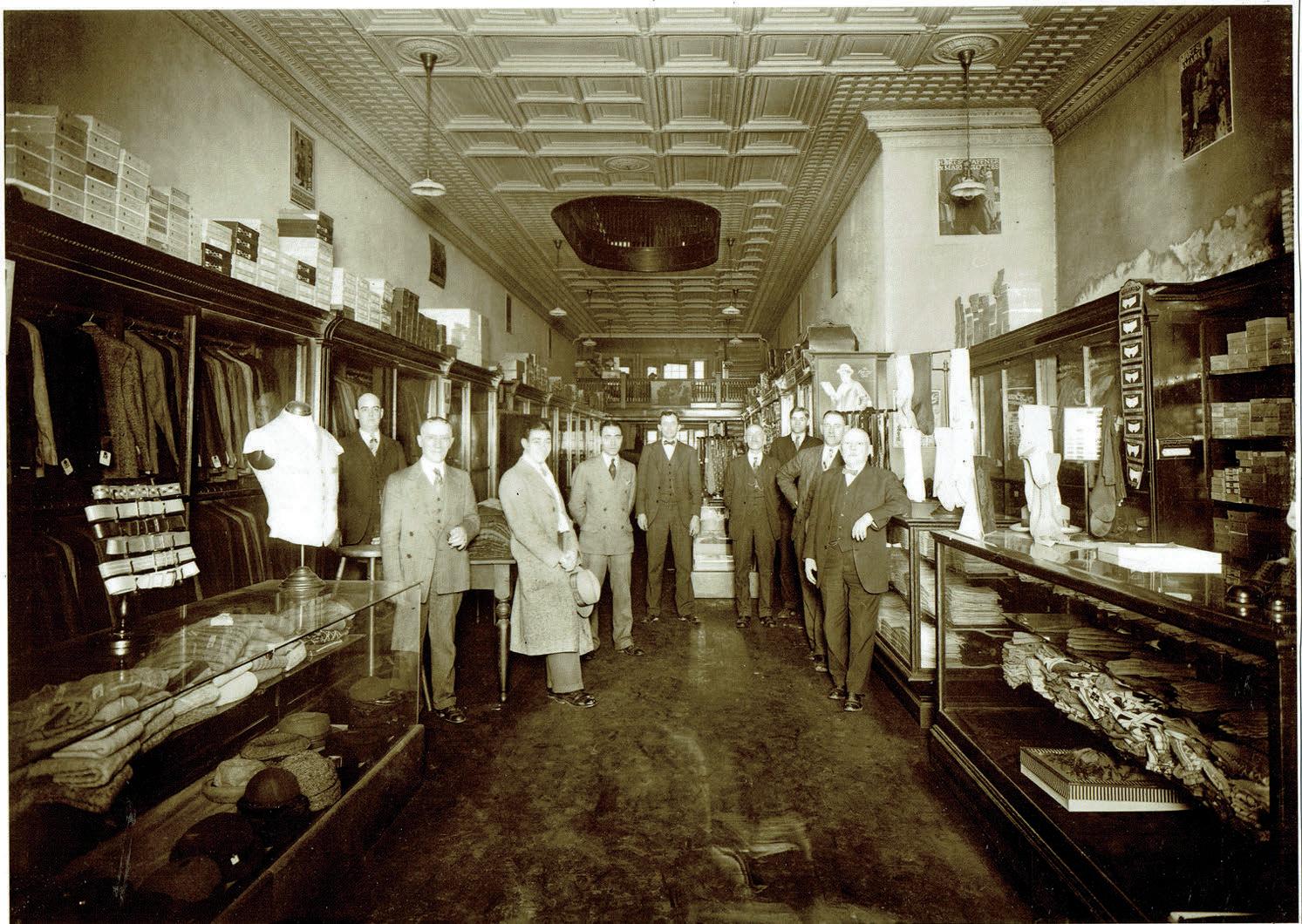

Mr. Weinberg had already been involved in the clothing business in Baltimore. As a young man, he stepped off the train at the Staunton station and asked a nearby police officer where might be a good place to open a clothing store. The officer told him that he might as well get back on the train, because Joseph Barth “had all the men’s trade tied up throughout this area.” Undeterred, Mr. Weinberg opened up the Weinberg Clothing Company at 5 S. Augusta Street. Unlike Barth’s store, he also carried women’s clothing.
He later married Johanna Barth, Joseph Barth’s half-sister. In 1911 the two stores consolidated to become Barth, Weinberg and Company. The consolidated store carried clothing for men, women, and boys.
Abraham Weinberg was a strong supporter of the local Jewish community. In 1924, the congregation was still worshipping in the small building on Kalorama street that had been purchased in 1886. One day Mr. Weinberg stood up in temple and proclaimed, “I’m tired of worshipping in something that looks like a warehouse! I’ll put up half the money for a real temple if the congregation will raise the other half.” He did and they did. The cornerstone for the current Temple House of Israel was laid the next year.
Abraham Weinberg also supported the community. He was a Mason and a Shriner. Eventually his partners L.G. Strauss and Joseph Barth retired, and then Abraham ran the business with his son, Irving. In addition to being a Mason and a Shriner like his father, Irving was also a member of the Rotary club and American Legion. Abraham and Johanna Weinberg left the temple an endowment, commemorated on a plaque in the sanctuary of the current temple. The family continued to have strong ties to the community, even though later descendants moved away. In 1996, Abraham Weinberg’s great-grandson had his Bar Mitzvah ceremony at Temple House of Israel in Staunton.
Alexander Hart (1839–1915) was born in New Orleans, and started out life as a store clerk. When the Civil War broke out, he enlisted and eventually became part of the brigade known as the Louisiana Tigers. He saw much action in the Civil War, was wounded several times, and achieved the rank of Major. At one point during the war, his regiment was ordered to pass through Staunton — apparently the first time he had been there.
Abraham Weinberg, circa 1940, from the archives of the Staunton Rotary Club, currently housed at Historic
Bottom: Interior of the Barth, Weinberg and Company clothing store, 1926. From the collection of the Historic Staunton Foundation.
Inset: An advertisement from Weinberg Clothing Co.
After the war, Major Hart married Leonora Levy and went into business with her family in Richmond. In 1876 he started a branch of the Levy dry goods business in Staunton on West Main Street (now West Beverley Street). Major Hart’s business failed in 1893 and he had to turn over all the contents of his store to satisfy his creditors. He then relocated to Norfolk.
Although Major Hart was in Staunton for a relatively short time compared with some of the other merchants, he had a lasting influence. He founded the congregation Temple House of Israel in Staunton, and was its first president, leading the congregation for 18 years. The congregation still exists today.

The parents of David L. Switzer (1868–1925) came to this country from Wuerttemberg (Germany). Abraham and Babette Switzer had a dry-goods store in Botetourt County. In 1880 they retired and came to Staunton. Born in Lexington, Virginia, David Switzer started off in the dry goods business, then worked as a jeweler. He opened the Grubert and Switzer jewelry store in 1898. His first location was in the Marquis building (corner Augusta and Beverley Streets) at 3 East Main Street (now East Beverley Street). The Historical and Industrial Edition of the Staunton Dispatch (January 1906) describes his shop as one which “contains everything of the finest quality. Superb diamonds, watches, clocks, beautiful cut glass and silverware adorn every inch of this spacious emporium.”
In 1911 he bought the building at 19 East Beverley Street. The firm of T.J. Collins was hired to design a new structure there. The original plans for the building are in the Collins Collection of Architectural Drawings at the Historic Staunton Foundation. The building, which now houses Shenandoah Pizza, has a distinctive façade of glazed white terra-cotta tiles resembling marble.
David Switzer married Minnie Cohen, the daughter of Louis Cohen. He was a long-time member of the Stonewall Brigade Band, playing the kettledrum and acting as vice-president of the organization.
Isaac Witz was possibly the most prolific business owner in Staunton, and was involved in clothing and furniture and milling. He was born in Austria (also listed as Prussia). His parents and siblings settled in Baltimore. In 1865, he married Fannie Heller, who came from Germany and was the daughter of Heiman Heller, a dry-goods merchant in Harrisonburg. His younger brother Moritz, listed as being born in Bohemia, came to Virginia in 1865 and became a citizen in 1876.
In 1865, Isaac ran a newspaper advertisement that he was selling a variety of items at a store on Beverley Street. He advertised “cheap for cash or in exchange for farm produce.” The offerings included “dry goods, groceries, hardware, iron stoves, machine oil, and the best articles of Spanish Sole Leather.”
In 1866 he purchased from Moritz Lowenbeck a three-story brick building on the north side of Beverley Street. In the 1870 census he was listed as a dry good merchant.
Isaac was a prominent member of the community. He was on the board of visitors for the School for DD&B (now the Virginia School for the Deaf and Blind) and was elected to city council in 1884.
In 1890, the brothers went their separate ways. Moritz moved to Baltimore, where their mother still lived. The store was still listed at 20 Main Street, but was under the new name of “Witz, Lightner, and Co.” The partners were now Isaac Witz, J.T. Lightner, and Isaac’s son Morris Henry Witz. Isaac’s daughter Leila married W.S. Burke. By 1898, the dry goods business was named Witz, Burke and Co. The store advertised, “Dry Goods, Notions, Carpets, and Housefurnishing Goods” The business had grown rapidly to include two adjacent storefronts. In 1906, the dry goods store’s spaces were rebuilt as the Witz Building.
In 1869, Isaac Witz and Charles Holt bought land on Lewis Creek near the present Commerce Road. They built a four-story mill, powered by water and later augmented by steam. The mill even boasted a fireproof brick elevator. In 1881, the newspaper reported that “a telephonic connection has been established between the store of Isaac Witz on Main Street with the mill of Messrs. Witz and Holt.” The paper went on to say that “they set an example which should be followed by other enterprising citizens” (i.e., business owners). Presumably the owners could be expected to recoup their expenses by the increased efficiency of using the telephone instead of the more common practice of sending messenger boys. The 1891 perspective map of the city of Staunton showed the location of the Witz and Holt Flouring Mill.
Witz and Holt sold the mill in 1895 and joined with two other businessmen to form White Star Mills Company. They built a modern steam-powered mill near the train station that remained in production as a mill until 1966. The mill now houses a restaurant, the Mill Street Grill.
Isaac Witz started Witz Furniture Industries in the 1890s. His son Julius Witz (1868–1936) ran two furniture stores, Basic Furniture in Waynesboro and J.L. Witz Furniture Store in Staunton.
Religiously, the family went in very different directions. Isaac’s brother Moritz was one of the original officers of Temple House of Israel, serving as secretary, and was a trustee in the purchase of the original synagogue. It appears that Isaac was never a member of the temple. At least three of Isaac’s children (Julius, Leila, and Rosalie) were baptized as adults in Emmanuel Episcopal Church. However, even after his baptism at age twenty-two and marriage to an Episcopalian, Julius continued to send generous donations to Temple House of Israel every year. Rosalie (Rose) later married Cordell Hull, Secretary of State under Franklin Roosevelt.
Julius Witz was also the president of Citizens Gas Company and served as mayor of Staunton from 1928 to 1932.
Merchants continued on page 24



Merchants continued from page 23
Moses (Mose) Walters originally came from Baltimore. He started his wholesale fruit and vegetable business about 1915. By 1916 he had established Walters’ Produce House at 102 E. Main Street. In 1926 he went into the business with Morris (Maurice) Cohen and Walter E. Cohen, sons of Louis Cohen. They called their company Augusta Fruit and Produce and operated at 5-7 Middlebrook Avenue.
Underneath this large warehouse was a cold storage room for the produce. Rhea Walters, Moses Walters’ wife, used to help out with the business. One day she went into the cold storage room, passed by the bananas, and a chilled but alive tarantula spider fell on her chest. She never went back into the building again.
The partners eventually split. Ten years later, Moses Walters operated the Walters Fruit and Produce Company out of the American Hotel building next to the C&O Railroad station.
Mr. Walters supplied fresh produce to small mercantile stores as well as institutions such as Augusta Military Academy, Mary Baldwin College, and the local public schools. He owned a number of local orchards, as well as a banana plantation in the Bahamas.

Albert Shultz (president), Fielding Olivier (secretary-treasurer) and Julius Witz formed the New Theatre Corporation. The New Theatre building was designed by T.J. Collins and opened in 1913. It showed burlesque and vaudeville shows, as well as silent movies. About 1925, the partners sold a controlling interest in the corporation to the theater corporation of Isaac Weinberg, a Jewish businessman from Lexington. Isaac Weinberg later sold 75 percent of his interest to Universal Pictures Corporation. The New Theatre first showed a “talkie,” “The Jazz Singer” in 1928.
The Staunton newspaper ran a contest to find a new name for the building in 1934. The contest was won by Mildred Klotz, Jacob Klotz’s daughter, who came up with the title of “The Dixie.” A fire in January 1936 destroyed much of the building. The rebuilt building, with only two stories instead of three, looks very different from the original.
Laws restricting immigration to the U.S. that were passed in 1921 and 1924 effectively ended the great wave of Jews coming into this country. The Staunton businesses that Jewish merchants owned are gone. But the buildings and pictures are still here to tell the story.
Staunton is the place to get things. For comfort things... for rest things... Things to help you look best in... All these things and many more, You can get in Staunton stores. <
Editor ’s note. This piece is a carefully researched investigation by Dr. Ruth Chodrow and Karen Lynne Johnson of the large number of Jewish merchants who established their businesses in Staunton in the late nineteenth and early twentieth centuries. This article is an abridgement of the more extensive original, which was published by the Augusta County Historical Society, and is being reproduced courtesy of the Historical Society (www.augustacountyhs.org) and the original authors. A copy of the complete article can be found on the Temple House of Israel’s website at thoi.org/jewish-merchantsof-downtown-staunton.

Making




Village Garden Center specializes in rare and hard to find plant material with a large selection of dwarf conifers, Japanese maples, vines, unusual flowering shrubs, evergreens, shade and ornamental trees, perennials, mulch and stone. In most cases, we can handle an entire landscaping project from conception to completion.


















































By Chris Lassiter
Back in 2020, Staunton Downtown Development Association (SDDA) was searching for ways to support local restaurants while keeping the community the community safe amongst a global pandemic. In a partnership with the City of Staunton, a plan was created to section off four blocks of West Beverley Street, allowing restaurants to move their seating outside. Open minds led to closed streets, and Shop & Dine Out in Downtown was a huge success.
The idea was so popular that it stuck. In 2025, Shop & Dine Out in Downtown will be back for a fifth season.


“I was really happy to see it, and I can’t say I’m surprised when I see how much support there was,” said Darren Smith, executive director of SDDA. “There were all of these reasons why maybe we shouldn’t do it, and then when it actually happened, everybody loves it, and doesn’t want it to go away.”
Between the natural beauty of Staunton, the architecture, the food and beverage choices and the retail options, Smith understands why the Shop & Dine Out in Downtown was enthusiastically embraced by the community.
“We have all of these chefs who come through the programs with high reputations — or worked under famous chefs — they are the things that get covered by travel magazines and travel bloggers,” Smith said. “It’s a good distance to travel from Charlottesville or Richmond. It’s a really good location. Obviously, we’ve got natural beauty and historic building stock. We have a lot things going for us, and restaurants just being one of them.”
Smith started in the executive director role at SDDA in July of 2024. That wasn’t his first interaction with the nonprofit organization. More than a decade ago, he was finishing graduate school at a Virginia Tech satellite campus in Alexandria.

Smith would come to Staunton to visit grad school friends. At this point, Smith was working on developing his own business, and he and friends ended up at the event put on by the Staunton Creative Community Fund (later re-named Shenandoah Community Capital Fund).
“It was one of those things where you go an introduce yourself and talk about what you’re working on,” Smith recalled.
“I described my business to everybody. I had been planning to launch in Washington, D.C., and everyone was like, ‘No, you have to do that here. I’ll connect you to this person and that person.’
I ended getting one of the Bright/ReWired grants that jointly administered to SCCF and SDDA.”

Smith ultimately did make Staunton the home base for his business. After decided to pivot in his career, the connections he forged while launch and maintaining a business in Staunton influenced his thoughts about the future.
“For the past decade or so, I’ve been running an interesting business called Traipse that did app-led historic scavenger hunt and activities,” Smith said. “That was based in here in Staunton, but I had clients all over the mid-Atlantic. I was looking for something else, particularly here in Staunton. When the position became open, I was excited at the possibility. I ended up taking the role in July.”
Smith hasn’t been in the position for a full year. One of his immediate goals is to hire an employee. While he’s still getting acclimated to the position, Smith also wants to Shop & Dine Out in Downtown to grow.


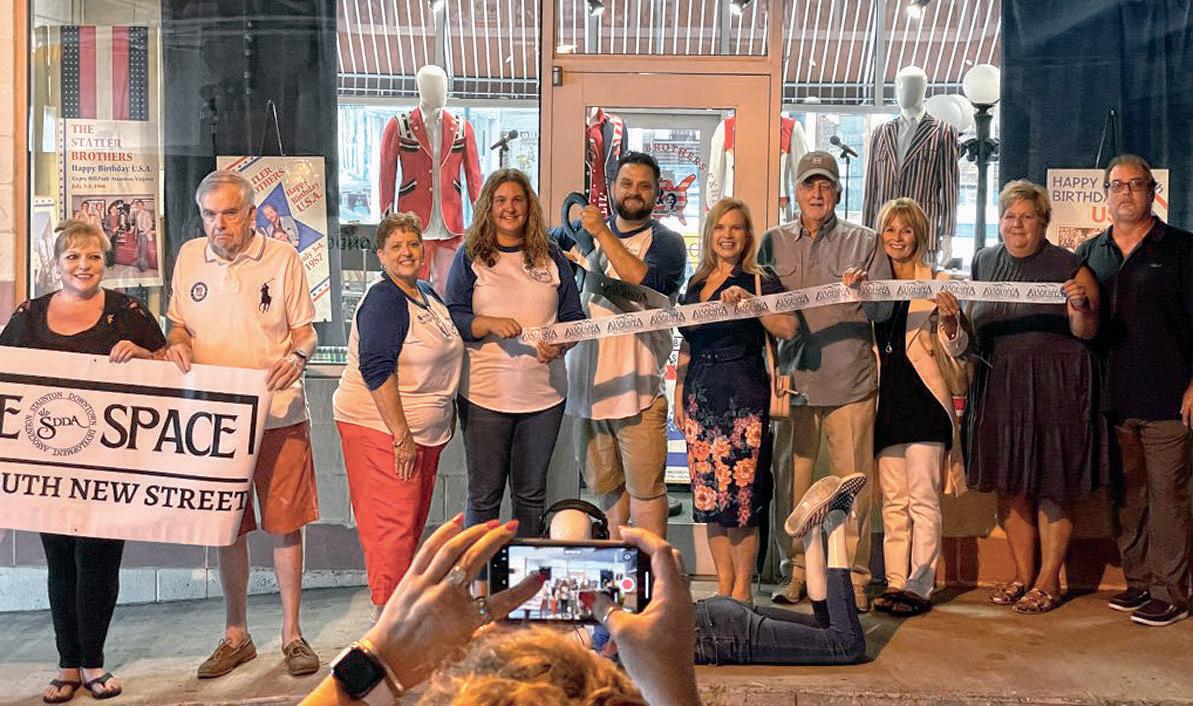


“I think we’ve got to do more to have consistent activity,” Smith said. “It varies from weekend to weekend, but there are often dead zones among the four blocks. One of the things I’ve been talking with the city about what we can do to bring activity to those places as well.”
One of the logistical challenges Smith hopes to troubleshoot is not having an event staff that build up or take down things for events over the weekend.
“I want to work with restaurants and have some of the restaurants that already have a process to be like, ‘Hey, can you throw a cornhole boards down in this space that’s next to you?’” Smith said. “I think people will be interested in that. I’m still looking for ideas, too. My theory around this if you can get groups that are already doing something that they could be doing on West Beverley Street, it could be advantageous for all of us.”

Even as Smith looks to add new wrinkles, he’s careful to keep in place the things that have worked. Part of what makes Shop & Dine Out in Downtown special is that downtown is more pedestrian friendly due to the re-routed traffic patterns for the weekend. In addition to pedestrians, it’s also a huge relief to parents.
Smith is confident that this year will be another amazing season for Shop & Dine Out Downtown, which begins in April and concludes in October.
“It’s going to be another great year of it,” The SDDA executive director said. “Every year, people are figuring out what works and what doesn’t work, how things work with the city and what the city needs from people. I’m looking forward to starting again.” <

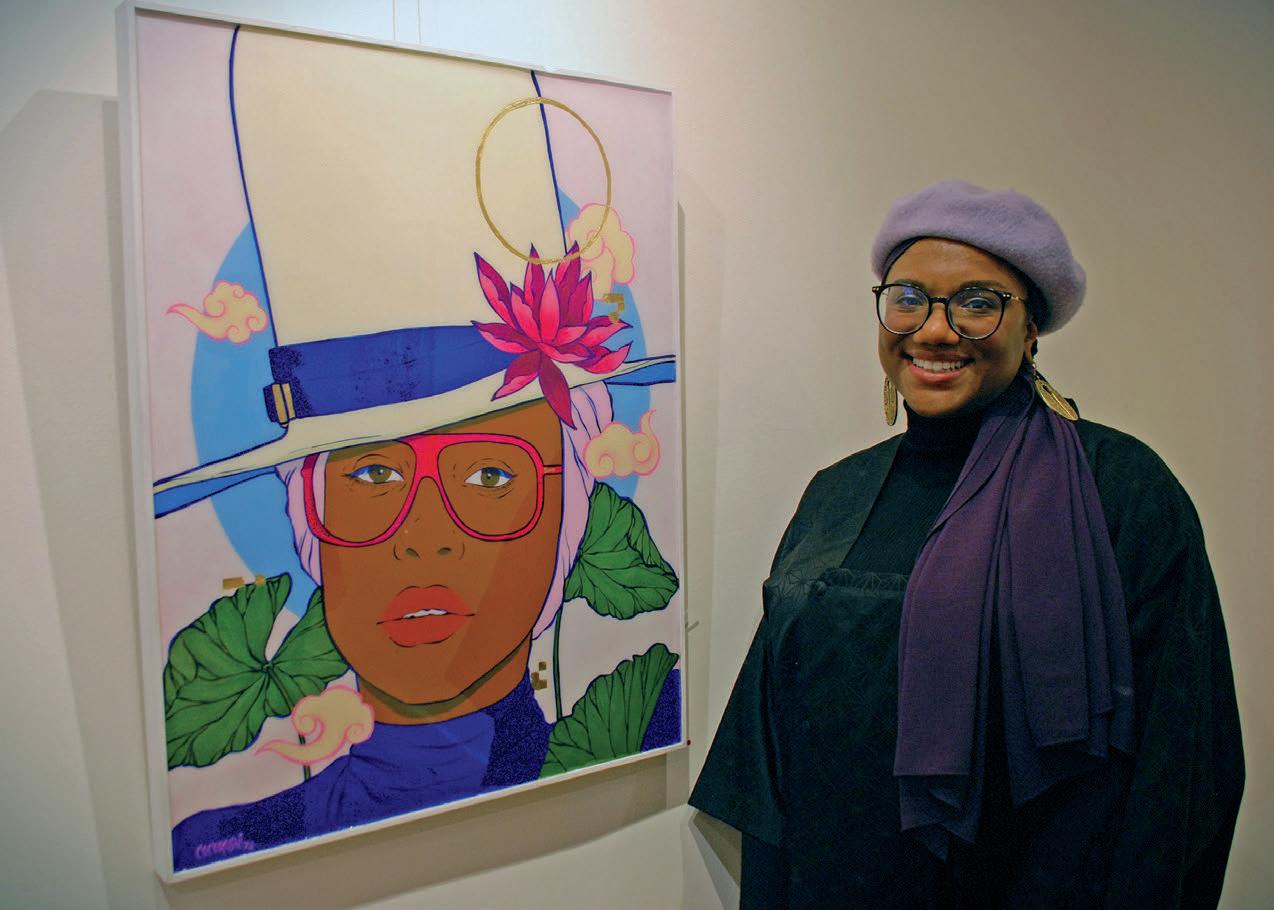



By Heather Cole
On a rainy Wednesday afternoon, Angelica Pena is browsing a selection of handmade pottery for sale in one of the galleries at the Shenandoah Valley Art Center (SVAC) in downtown Waynesboro, Va. The Waynesboro resident says that she was in town running errands and stopped by to pick up a hostess gift for a dinner later that evening.
“I wanted to get something more interesting than a candle from Target,” Pena says. “I love purchasing neat local things that no one else has.”
The pottery that Pena was browsing was all made by artist members of the SVAC. In addition to providing retail space for members to sell their art, the Center also curates exhibits, provides studio space, offers educational programs and hosts opportunities for beginning and experiences artists to connect with each other and art lovers from across the Shenandoah Valley.
“We are a hub for the creative community,” explains SVAC director Piper Groves, herself an artist at the Center. “We place equal emphasis on the community-building aspect of our mission, as we do on the art.”
The SVAC is a nonprofit membership organization with several levels of memberships available for both working artists and patrons of the arts. Experienced artists can rent studio space and participate in juried shows; members who are still learning their crafts can take classes, participate in open shows and display their art for sale at the Center. For art fans and collectors, SVAC patron members get discounts on gift shop purchases and access to member-only events.
SVAC was founded in 1986 by a group of local artists and educators. Among those original founders was Lyndhurst, Va., resident and ceramic artist Lynn Hilton Conyers, who taught art at Waynesboro High School for more than three decades and now serves on the board of directors of SVAC. She remembers taking high school students to the Center to attend exhibit openings and exhibit their own work.
“To me, art didn’t happen just within the four walls of a classroom,” Conyers says. “I wanted my students to get to know the local art community.”
The Center currently has 200 members who range in age from teenagers to retirees. They paint, draw, print and work on computers, and create art in clay, fabric and a variety of other media. Some make a living selling their art; others are retirees or hobbyists. According to Groves, all are welcome at the SVAC.

We focus on the whole boy— not just his GPA. Our small class sizes give each boy the individualized attention he deserves. He will learn how to solve problems, and become a leader amongst his peers. Our classical curriculum focuses on accountability, positive teambuilding, and physical fitness. Every boy should have the opportunity to be seen— and at Fishburne Middle School, we see what’s great in him.

Grades 6 through 8 | Day Students




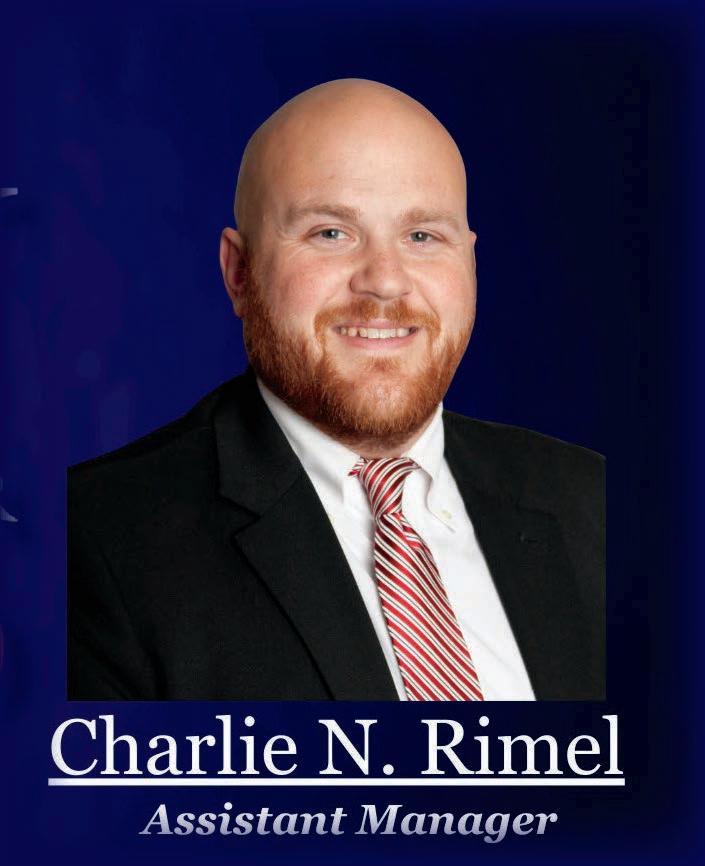


Art Center continued from page 28
“We believe that the art world needs fewer barriers,” Groves says. “People can be intimidated by are and we want to break that down.”
The SVAC is currently home to 12 in-house studio artists who work their craft most days the Center is open. Members and visitors can wander the Center and peek in on the working artists.
On one afternoon, artist Marti Reed is working in her studio on a commissioned miniature portrait of a pet iguana. She is surrounded by much larger portraits of people and animals, both domestic and wild.
“I always paint the eyes first,” Reed says. “Once I get their eyes right, then I’m able to capture who they are.”
Reed says that she loved art as a child but pursued careers in numerous other fields, including sales and nursing. As she was approaching retirement, Reed attended an art show by a family friend and was inspired to pick up a paintbrush and venture back into the art world. Reed started with a shared studio space at SVAC, but soon had produced so many paintings that she required a space of her own.


Reed says that one of the best parts of the Center is the informal connections that happen between artists as they work and engage with the work of others.
“I’ve learned a great deal by watching other artists and of course asking lots of questions,” she says. “It is a wonderful little community where we share and support each other.”
Another local artist exhibiting her work at the SVAC is Liisa Westen of Waynesboro. Westen took a class in pottery in 2019, discovered that she enjoyed it, connected with other potters in the area and eventually joined the Center.
“I needed to have a hobby in my retirement, and this keeps me busy,” Westen says. “I enjoy making pottery because it is peaceful, centering and meditative.”
Over the winter holidays she was part of a pottery exhibit hosted at the SVAC in partnership with a local clay studio, Make Waynesboro.
The SVAC moved into their space at 126 South Wayne Street in 2007. The original space currently includes gallery space, several artist studios and the Center’s gift shop. They found that demand by local artists and the wider community continued to grow and in 2023 the Center expanded to a second location at 416 West Main Street. The building was beautifully renovated to encompass a gallery, print shop, studio space, classroom and rental apartment. The gallery and classroom are also available for private rentals for weddings, parties or meetings.
The SVAC is open on Tuesdays-Saturdays from 10 a.m.-4 p.m. The Center hosts a two-day Fall Foliage Art Show on the second weekend in October and a variety of curated and open exhibits throughout the year.
The Center offers art education for all ages and abilities. There are adult classes in drawing and watercolor. Twice a month the print studio offers a demo for interested artists. A summer camp for children ages six to 12 is offered in July.
The Center will celebrate its 40th anniversary in June 2025. Final plans for festivities were still under development when this story went to print, but details for that and other programs and events are available on the SVAC website: svacart.com. <



























By Courtney Thompson
Baseball player Leon Brown once said, “He who can turn negative situations into something positive has learned the law of transformation; his mind empowers life.” This quote certainly describes how Augusta Health turned the negative of a global pandemic into something very positive — and transformational — for our community.
When COVID-19 vaccines became available to the public in early 2021, Augusta Health quickly set up a clinic on their main campus to serve anyone who wished to receive the vaccine. Although thousands of area residents were seen at this clinic, Augusta Health’s medical team realized they were missing just as many who either couldn’t get to the clinic, were unaware of it, or were simply distrustful of visiting the hospital to receive any kind of medical care. With that realization, Augusta Health’s community outreach program began hosting vaccination events at a number of locations, from churches to community centers to nonprofit organizations that serve a specific population.
Fast forward to 2025, and Augusta Health now hosts over a dozen neighborhood clinics each month, bringing “comprehensive primary care to underserved members of the community, regardless of status, income or education level, insurance, disability, citizenship, or preferred language.”
Not only is primary care available at these clinics, but other services are offered, such as food assistance, chronic disease management, mental health counseling, and help with Medicaid enrollment and financial assistance. “A lot of our older population lives in rural communities and aren’t able to access medical care easily,” says Issac Izzillo, Director of Public and Primary Care Services for Augusta Medical Group. Izzillo was the catalyst for the mobile clinic model at Augusta Health, after noticing the health disparities around the county as the team hosted vaccination events.




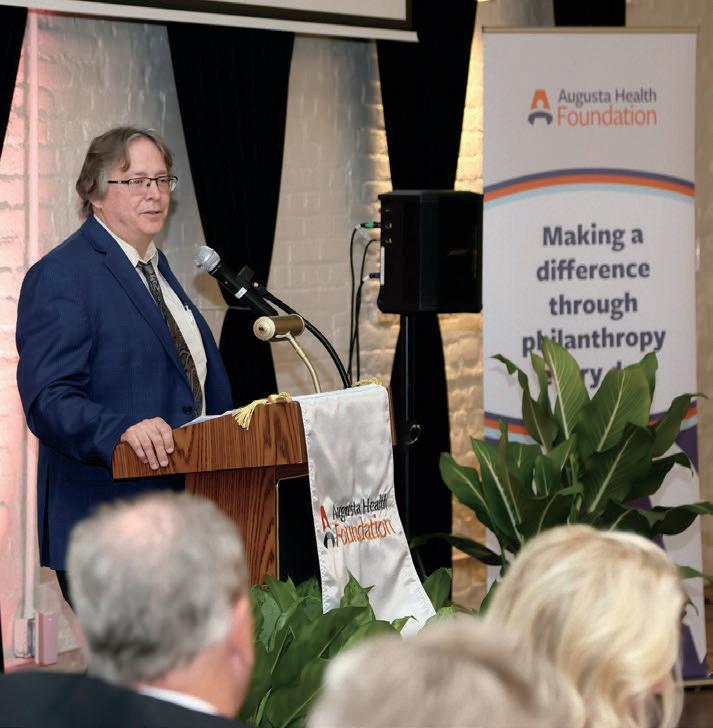
These sites aren’t chosen randomly — the Augusta Health team, led by Izzillo and Dr. Clint Merritt, Senior Vice President and Chief Physician Executive/Chief Medical Officer, researched patients who had repeated visits to the Emergency Department to see if they were regular patients of a Primary Care Physician. The majority of them were not. “Regular preventative primary care contributes greatly to a person’s overall health,” Izzillo explains. “We used this data to literally take a map of Augusta County and overlay it with an Area Deprivation Index.”
The areas that ranked highest revealed to the team where neighborhood clinics were most needed, often in more rural locations of the county where accessing the hospital or a primary care physician is challenging due to a lack of transportation or the expense of visiting a doctor is prohibitive. There are also those who don’t trust standard medical practices, but the consistency of seeing familiar faces month after month at these neighborhood clinics is breaking down those barriers.
“The community partnerships are so important to the neighborhood clinics,” Izzillo says, referring to the churches, community centers, and town buildings that host them. However, these spaces aren’t always conducive to medical care, as the team must set up privacy screens and tote in supplies each time.
Enter the Augusta Health Foundation, the charitable arm that encourages community giving to ensure “the right care, in the right place, at the right time,” according to Shirley Carter, Executive Director and Vice President of Philanthropy. “We partnered with the Neighborhood Clinic team so that all in our community have access to medical care.”
In April 2024, Augusta Health Foundation launched a campaign to raise funds for a customized, fully equipped mobile medical unit that will have two exam rooms and a lab area. This will allow for expanded services and the ability to reach even more Augusta County residents with needed medical care.

“Thanks to generous donors and stakeholders who share the vision, $600,000 was raised to meet the goal!” Carter says, excited to share that the mobile medical unit should be delivered and ready for use mid-2025. “Now we will focus on inviting community members to support each clinic that operates in the neighborhoods.”
“We would love to eventually partner with some of our large employers to bring the mobile medical unit to their locations as a way to support the health and wellbeing of their employees,” adds Peggy Caister, Development Officer for Augusta Health Foundation.
The entire neighborhood clinic team, along with support from Augusta Health’s leadership, is looking forward to a more efficient way to serve their patients out in the community and continue to see improvement in the health of our community. “We’re so humbled by the support of the community, Augusta Health leadership, and Board of Directors,” shares Izzillo. “It’s very powerful to see how much the community cares.”
For more information or a list of available neighborhood clinics, visit www.augustahealth.com/service/neighborhood-clinic/. You can also find ways to give, volunteer, and spread the word about this great work happening at our local hospital system. <

By Chris Lassiter
Aperson’s eyesight may eventually fade, but the love of books shouldn’t. That’s exactly why the Talking Book Center exists.


The local nonprofit organization provides free access to the National Library Service for the Blind and Print Disabled, which includes a catalog featuring thousands of books for community members who are either blind, low vision or print disabled.
Through the Talking Book Center, community members who could no longer read print books themselves are rediscovering their love for books. Ilia Desjardins, supervisor of the Talking Book Center, couldn’t be happier about it.
“When people are diagnosed with an eye condition, there’s this (notion of), ‘Well, you’ll never be able to read again,’” Desjardins said. “Then they find out about the service, and they say, ‘I’ll start with one book.’ They enjoy the book, and then they are like, ‘You know what, I read a book 30 years ago. Do you have it?’
And I’m like, ‘Yes, we do.’ Our collection is at 200,000 audiobooks. They get excited about reading again.”







The Talking Book Center is one of 45 subregional talking book libraries in America.
Located on the second floor of the Staunton Public Library, the local Talking Book Center was founded in 1981 as a member of the National Library Service of the Blind and Print Disabled in Washington, D.C. The center services Staunton, Augusta County and Waynesboro in addition to Rockbridge County, Bath County and Highland County.
The Talking Book Center caters to people with a wide range of vision impairments.





The Talking Book Center is located on the second floor of the Staunton Public Library.










“Blindness is a spectrum,” Desjardins said. “It goes from anyone who was born blind, or has low vision. Blindness qualifies as 20 over 200 with corrective lenses. Vision impairment includes macular degeneration, diabetic retinopathy; any sort of vision impairment that prevents reading a printed book.”

Inset: Louis Braille invented a reading and writing system of raised dots for use by visually impaired people, still in use today. While the introduction of the Braille system was revolutionary, today’s modern Talking Book system is much more accessible for the visually impaired.
Similarly, being print disabled covers everything that makes holding a book difficult.



“A physical impairment would include something like Parkinson’s (Disease), multiple sclerosis, muscular dystrophy, cerebral palsy” Desjadrins continued. “Even arthritis in your fingers, which prevents you from turning pages, anything like that qualifies.”





Community members wishing to participate can fill out an application. Once approved, it’s a pretty simple process to start receiving books.
“It takes about 15 minutes to set up a new patron,” Desjardins said. “Then they have the machine, the headphones and the audiobooks.”
Some of the books are written in braille, but the majority of the collection of books are digital audiobooks.

“The patron receives the machine on a long-term loan, usually through the mail,” Desjardins said.”They can walk in and pick one up. The audiobooks are downloaded on a cartridge — a USB flash drive — and then that is sent through the mail free of charge to that person’s house. They take the cartridge out of the box, and put it into the machine. It’s very similar to old school cassettes with a box, but it’s all digital.”
As the reader advisor at the Talking Book Center, Jennifer Kidd sees the difference the Talking Book Center makes.
“We had a huge, avid reader. When her sight began to fail, it threw her into an even deeper depression,” Kidd said. “Helping people like her find titles — and just be able to independently have this entertainment on their own without anybody else — is really important.”

There’s a wall in the Talking Book Center flooded with Post-It notes. Each one is a book review from a patron, who attached her response to each book to the cartridge.



“I told her we were putting them on the walls,” Desjardins said. “She said, ‘You’re going to need bigger walls.’ She’d read the book and write. Not all of them got reviews. The really bad ones got reviews, and the good ones got a little smiley face.”





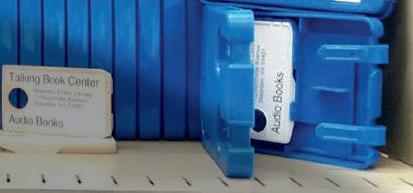




That particular patron, who recently passed away, would chat with Desjardins once a week on the phone. Many times, Desjardins would call just to check in on her.
It’s that type of service and connection that helped the Talking Book Center win the National Library Service for Blind and Print Disabled national subregion of the year in 2018.
“It’s for great customer service,” Desjardins said of receiving the award. “Just knowing what people want - and approaching it from a customer service angle - definitely helped. I was excited that hard work paid off.”
Desjardins doesn’t love books as much as she loves creating access to books. And with good reason. There’s never been a time in her life that she hasn’t been an advocate.
“For me personally, my younger brother was born with spina bifida,” Desjardins said. “He was born in 1987, before the Americans With Disabilities Act was a thing. My stepfather had muscular dystrophy. I was raised advocating for disability rights, people getting access to things. My mom would struggle for him (my brother) to get into the school without a ramp. I just grew up with that advocacy mindset.”

Her goal now is to spread the word about the Talking Book Center, so that everyone who could benefit from it knows about it.

“The service is free. The newsletter is free. The shipping is free,” said Desjardins, who said the center currently services around 300 patrons. “It’s just a matter of getting to the people that need the service.” <










By Chris Lassiter
For Jeff Coffey and Bessy Peralta, three is the magic number.
Coffey and Peralta stumbled upon Staunton. Not long after, they became owners of a trio of restaurants all within a four-block radius of one another in downtown Staunton.
Latin Soul combines flavor traditions from both of their distinct cultural backgrounds. “Latin is Bessy. She does all the Latin food on the menu,” Coffey said. “And the soul is me.” Sweet Addie’s is a waffle shop that existed before Coffey and Peralta took over ownership, and Helios is a grab-and-go Mediterranean spot located off of South Augusta Street.

As a former area manager for a restaurant chain, Peralta has experience overseeing multiple eatery locations. However, this time it’s different. Peralta is not the employee. She’s the co-owner.
“The idea was only one (restaurant),” Peralta said. “I was thinking that I was working for a big corporation, where I was putting all my potential right there, working like it was my own business. I was there from 7:00 a.m. in the morning until 9:00 p.m. at the night time. So now, why not work for something that is mine?”
Coffey and Peralta both had reasons to relocate from Colorado to Virginia. Coffey, who did five active years and five years in the reserves of the U.S. Army, had a successful network engineering career with a cable company.

“I was a network engineer, and they laid off my whole group,” Coffey said. “I was looking for something. My father had passed away last year from Alzheimer’s, and my mother is really old. I was looking for something I could do and still take care of my mother.”
Peralta had a job opportunity to be an area manager at a restaurant chain in Virginia. When Peralta’s career move proved to not be an ideal fit, her entrepreneurial instincts kicked in, and she started her own food truck.
Top: Restauranteurs Bessy Peralta and Jeff Coffey take a break from managing three local restaurants. © Patrick Hite – USA TODAY NETWORK via Imagn Images.





Having held almost every position imaginable in the restaurant industry, the transition to a food truck was difficult. “The food truck was me saying I don’t want to work for a big corporation,” Peralta said. “ I want to do what I want, which is cook, and be in the kitchen, and be around people. I started my journey in the food truck, but it didn’t work.”
The pipes would freeze in the winter. The truck would be too hot in the summer. Additionally, the health department guidelines are more stringent for food trucks, especially for ones without electricity. Peralta would have to start the meal prep fresh every day, and throw out whatever wasn’t sold. The silver lining was that a customer who loved the food truck told her to try parking it in Staunton.
“The lady, who owns the shopping center where Planet Fitness is, tried my food over in Charlottesville,” Peralta said. “She started telling me, ‘Bessy, you have to come to Staunton. Your food is really good.’ I came and parked my food truck there for a couple days, and the people welcomed me, and it was really awesome. I made a lot of friends.”
The warm reception for the food truck made Peralta set her sights on a brick-andmortar restaurant in Staunton. “We ended up finding 300 Church Street,” she said. “That’s where we started Latin Soul.”


Peralta has decades of restaurant experience, and she handles much of the daily operations. Although Coffey has also cooked all of his life, too, he tends to focus more on the business side of the restaurant.Coffey imagines start-up costs for a new restaurant to be around $100,000, but it’s a number that can be cut in half if the location already has the restaurant equipment. That’s what made the Latin Soul building so attractive.

It also explains how Coffey and Peralta came to take over Sweet Addie’s. “The second one, Sweet Addie’s, kind of fell in our lap,” Coffey said of the waffle shop, which is located on the corner of West Beverley Street and South Lewis Street. “We weren’t going to purchase it. We were just going to buy equipment. The price was right. We looked at the numbers. It’s not a ‘get rich’ place, but it’s a steady truther.”
One of the chefs that trained Peralta in Colorado was an expert in Mediterranean food. The job that brought Peralta to Virginia centered around Mediterranean food. She brought her knowledge and expertise to Helios. “It’s in a historic building right by the train station,” Coffey said. “Any time the train comes by, we’ll have a few customers.”
All three restaurants give Peralta the ability to do what she loves best: make delicious food and interact with people.
“My favorite part is the people,” Peralta said. “I love my employees like my family. I’m not saying I’m perfect. With this field, you can feel stressed, and sometimes you don’t know what is coming next, but I do care for everybody.” <


15 9 am-1 pm, Hometown Expo, Augusta Expo, Greater Augusta Regional Chamber of Commerce.
15 4 pm & 7:30 pm, Twitty & Lynn: A Salute to Conway and Loretta, Wayne Theatre.
19 4 pm & 7:30 pm, Celtic Angels Ireland, Wayne Theatre.
22 7 pm, Studio Wayne’s Seussical, Jr., Wayne Theatre.
23 2 pm, Studio Wayne’s Seussical, Jr., Wayne Theatre.
25 8:30 am, Marketing Tips and Tricks, Chamber office, Greater Augusta Regional Chamber of Commerce
27 5:30 pm, Business After Hours, Augusta Event Center, Chamber member event.
1 7 pm, Brothers Doobie, A Doobie Brothers Experience, Wayne Theare.
4 8:30 am, Coffee and Connections, Patrick Blevins State Farm, Greater Augusta Regional Chamber of Commerce.
5 Shop & Dine Out Resumes, Downtown Staunton.
8 9 am-noon, National Civics Bee, Blue Ridge Community College.
9-10 Fishersville Antiques Expo, Augusta Expo.
10 8 am-4 pm, Leadership Greater Augusta, Locations Vary, Greater Augusta Regional Chamber of Commerce.
10 7:30 pm, Jim Witter, The Piano Men, Wayne Theatre.
11 9-10 am, Aging In Place, Location TBD.
12 6:30 pm, Shakespeare Uncorked at the American Shakespeare Center. Brothers Craft Brewing — pair it with The Comedy of Errors
12 7 pm, Alice By Heart, Wayne Theatre.
13 2 pm, Alice By Hear t, Wayne Theatre.
17 5:30 pm, Business After Hours, Michael Bailey Farmers Insurance. Chamber member event.
17 7:30 pm, Uptown: A Celebration of Motown and Soul, Wayne Theatre.
25-27 Rent, Wayne Theatre: Info at waynetheatre.org/events for showtimes.


3 10am-5 pm, Riverfest 2025, Constitution Park, Waynesboro.
4 Augusta County Railroad Museum Train Show, Augusta Expo.
5-7 Staunton Jams, Downtown Staunton: Info at stauntonjams.com.
8 8 am-2 pm, Leadership Greater Augusta Graduation, Greater Augusta Regional Chamber of Commerce.
8 7:30 pm, Alfreda Sings The Divas Of Soul, Wayne Theatre.
9 9-10 am, Aging In Place, Location TBD.
9 7:30 pm, Sal The Voice, Wayne Theatre.
10 7:00 pm, The Legendary Doo-Wah Riders, Wayne Theatre.
15 5:30 pm, Business After Hours, Vector Industries. Chamber member event.
16 7:30 am, Chamber Golf Tournament, Ironwood Country Club.
16 7:00 pm, Jimmy Fortune, Wayne Theatre.
17-18 Virginia Street Arts Festival, Downtown Waynesboro: Info at www.visitwaynesboro.com/events/2025-virginia-street-arts-festival.
20-22 Red Wing Roots Music Festival, Mt. Solon, info at redwingroots.com.
30 7:30 pm, Beausoleil avec Michael Doucet, Wayne Theatre.
6 8:30 am, Coffee and Connections, Best Western Plus Waynesboro, Greater Augusta Regional Chamber of Commerce.
6 11 am-6 pm, Hiker Fest, Downtown Waynesboro.
12 8:30 am, Hot Topics Series, Queen City Place, Greater Augusta Regional Chamber of Commerce.
13 9-10 am, Aging In Place, Location TBD.
19 5:30 pm, Business After Hours, Holiday Inn Staunton Conference Center. Chamber member event.
3-4 5-10 pm 7/3, 7 am-10 pm 7/4, Happy Birthday America, Gypsy Hill Park, Staunton.
11 9-10 am, Aging In Place, Location TBD.
25-27 BaroqueFest, Bach’s Passion: Info at stauntonmusicfestival.org/baroquefest.
26 Historic Garden Week Tour, Staunton: Info at www.gcvirginia.org/historic-garden-week/tours/staunton/#tour.
26 7:30 pm, A Brahms Festival, Waynesboro Symphony Orchestra, First Presbyterian Church Staunton.
27 7:30 pm, John McCuthcheon, Wayne Theatre.
27 7:30 pm, A Brahms Festival, Waynesboro Symphony Orchestra, First Presbyterian Church Waynesboro.
29 8:30 am, Business Outlook Breakfast, Best Western Waynesboro, Greater Augusta Regional Chamber of Commerce.
1-3 4-H and FFA Market Animal Show and Sale, Augusta Expo.
2 8:30 am, Coffee and Connections, Horizons Therapy, Greater Augusta Regional Chamber of Commerce.
2-3 Spring Market, Augusta Expo.
2-4 Rent, Wayne Theatre: Info at waynetheatre.org/events for showtimes.
12 6:30 pm, Shakespeare Uncorked at the American Shakespeare Center. Show and partner coming soon. Info at americanshakespearecenter.com/ events/shakespeare-uncorked.
17 8:30 am, Hot Topics Series, Queen City Place, Greater Augusta Regional Chamber of Commerce.
17 5:30 pm, Business After Hours, F&M Bank, North Augusta Street. Chamber member event.
22-26 Augusta County Fair, Augusta Expo, info at www.augustacountyfair.com.
August
1 8:30 am, Coffee and Connections, Select Bank, Greater Augusta Regional Chamber of Commerce.
7 8:30 am, Hot Topics Series, Queen City Place, Greater Augusta Regional Chamber of Commerce.
8 9-10 am, Aging In Place, Location TBD.
15-24 Staunton Music Festival, info at stauntonmusicfestival.org/summer.
21 5:30 pm, Business After Hours, E-N Computers, Waynesboro. Chamber member event.
28 5:30 pm, Women in Business Thrive 25: Ladies Night Out, Queen City Place.
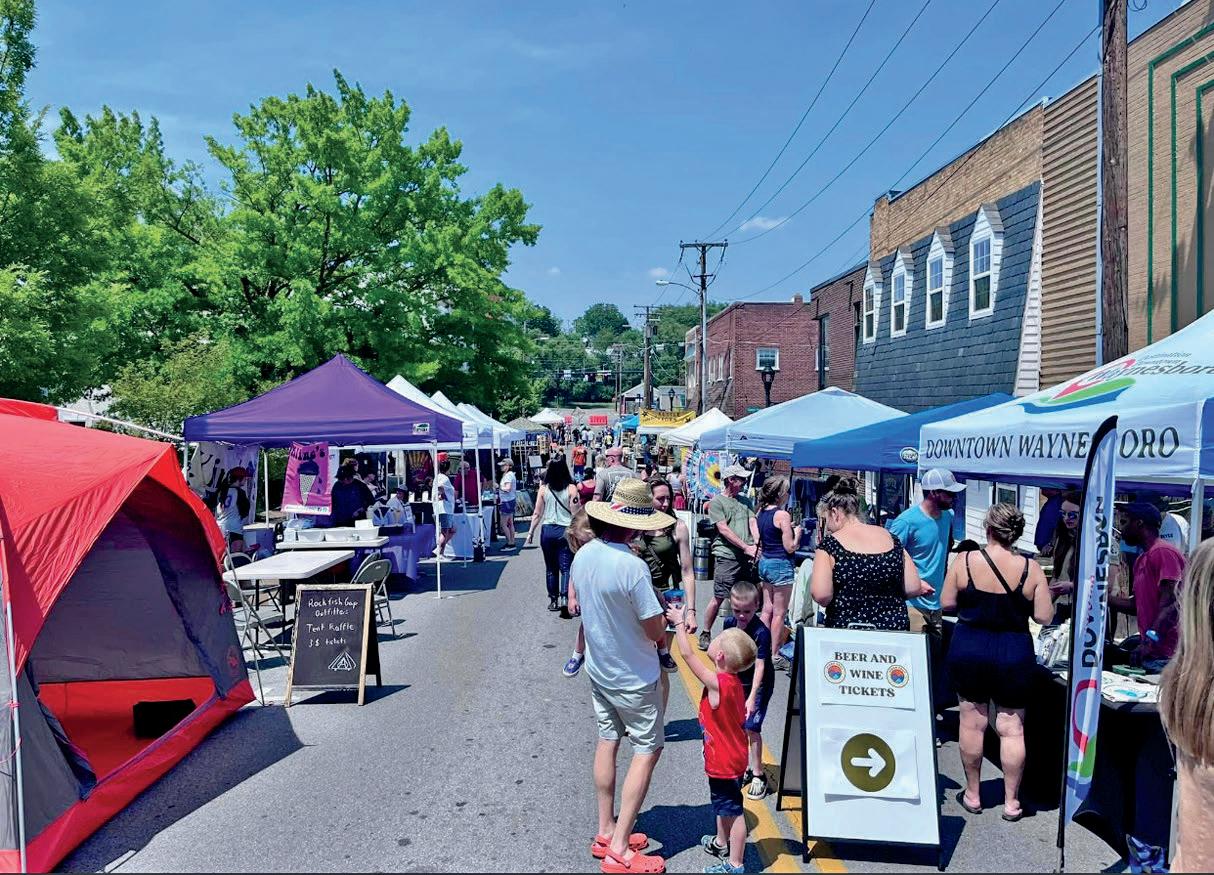

5 8:30 am, Coffee and Connections, Bookkeeper.com, Greater Augusta Regional Chamber of Commerce.
11 8 am, Leadership Greater Augusta Retreat, Location TBD, Greater Augusta Regional Chamber of Commerce.
12 9-10 am, Aging In Place, Location TBD.
13 Noon-9 pm, Virginia Chili, Blues and Brews Festival, Downtown Waynesboro.
13 6:30 pm, Shakespeare Uncorked at the American Shakespeare Center. Show and partner coming soon. Info at americanshakespearecenter.com/ events/shakespeare-uncorked/
18 5:30 pm, Business After Hours, The Blackburn Inn. Chamber member event.
26-28 Queen City Mischief and Magic, Downtown Staunton: Info at facebook.com/queencitymagic.
American Shakespeare Center’s Blackfriars Playhouse
Feb. 6 – April 19 Little Women
Feb. 13 – April 19 King Lear
March 20 – April 20 The Comedy of Errors
May 1 – Aug. 2 Sense and Sensibility
May 1 – Aug. 2 A Winter’s Tale
Aug. 29 – Nov. 16 Romeo & Juliet
Aug. 29 – Nov. 16 Two Gentlemen of Verona
Aug. 29 – Nov. 16 A world premier title unreleased as of presstime.
Go to AmericanShakespeareCenter.com for specific dates and to order tickets.
Playhouse Tours are generally available Wednesdays-Fridays at 2:00 PM, and Fridays-Saturdays at 10:00 AM. (PLEASE NOTE: dates and times may vary based on student matinees and the overall Playhouse schedule). Tours last about 45 minutes. (Fee) Info at americanshakespearecenter.com/events/playhouse-tours.
Wayne Theatre
For films and events not scheduled at press time, go to: waynetheatre.org
The Foundry
Live Music, info at www.thefoundrysound.com/shows.
Staunton Farmer’s Market
Saturdays, 7 am – Noon, April-September. 8 am – Noon Oct. – Nov. 23.
Winter Market, Dec. 7, 14 & 21, 9 am – 1 pm. Wharf Parking Lot.


3 8:30 am, Coffee and Connections, Converge, Greater Augusta Regional Chamber of Commerce.
4 6:30 pm, Shakespeare Uncorked at the American Shakespeare Center. Show and partner coming soon. See americanshakespearecenter.com/ events/shakespeare-uncorked/. 10-11 Fishersville Antiques Expo, Augusta Expo.
Waynesboro Farmer’s Market
Saturdays, 9 am – 1 pm, May – October. Constitution Park Pavilion.
Waynesboro Public Library
Preschool Story Time: Wednesdays 10-11am.
Ages 3-5 and caregivers.
Play & Learn: Tuesdays 10:00-noon. Ages 0-4 and caregivers.
Baby & Toddler Story Time: Fridays 10-11am.
Ages 0-3 and caregivers.
Yarns of Love at the Library: Mondays 4-6 pm, All ages.
Memory Partners: Second Thursday monthly, March-November, 10 am.
For more events, see www.waynesboro.va.us/1199/Library.
Staunton Public Library
Memory Café: Third Thursday monthly, 2 pm.
Geri-Fit: Exercise for older adults, Wednesdays 11 am.
Great Books Club: Second Friday monthly, 2 pm.
True Crime Discussion Club: first Thursdays monthly, 7 pm.
For more events, see www.ci.staunton.va.us/departments/library.
Fridays With Friends: Fridays 10:30 am, Fishersville. Redbeard Book Club: Third Sundays 3 pm. Adults 21+.
In partnership with Staunton Public Library.
WCLS Brown Bag Book Club: Second Wednesdays, Noon, Weyers Cave Library Station. Adults age 19+.
For more events, see www.augustacountylibrary.org.




























This allegorical painting shows the power of cumulative thought in the building of a civilization It features great historical figures such as George Washington, Cleopatra, Plato, and Abraham Lincoln Like the building of the pyramids, one stone upon the other, our civilization is but the sum-total of the work of those countless millions





Dr. Walter Russell conceptualized this painting while standing on the end of a wharf in Brooklyn looking across the East River towards New York City. One by one the characters which his mind conceived grouped themselves around him - all looking towards the skyline.





















The lesson one might learn from this painting is that you should love your work and do it with all of the force of your will, with all the power that your love for it engenders, no matter how humble or great that work is, for it is of supreme importance in the building of the great structure of civilization. You are important!



























At First Bank and Trust Company, we are the bank that puts you first. Whether you are stepping into home ownership, running a small business, or searching for the best bank account for your daily needs, we are here to provide you with the timely support and expertise you need from your bank.


At First Bank and Trust Company, we are the bank that puts you first. Whether you are stepping into home ownership, running a small business, or searching for the best bank account for your daily needs, we are here to provide you with the timely support and expertise you need from your bank.
